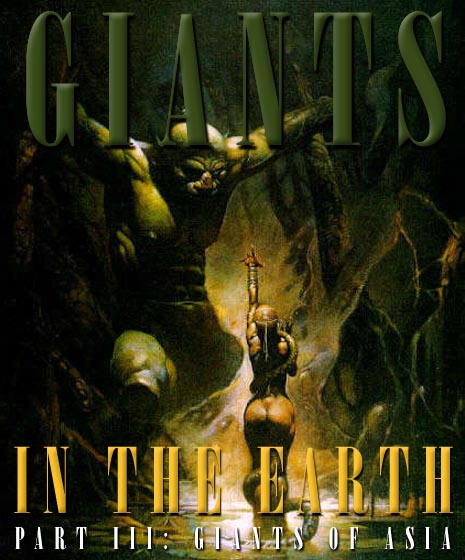
Editorial
|
Press Releases
|
Book Reviews
|
Fragments
Grand Canyon I
|
Giants III
|
Osiria III
Register
for our new Hall of Records Newsletter!
Questions? Comments? Suggestions? Advertising? Press Releases?
Contact us!
Part I: Giants of the ANE
|
Part II: Giants of the Americas
|
Part IV: Giants of Europe
NEW!
Giants of Asia Discussion Board
(Requires Registration)
The Table of Nations
|
The Wars of Gog and Magog
|
Magog, Prince of the East
Giants of Asia
|
Hunting for Giants
Giant Links
|
Giant Books
|
Audio
|
Video
|
Posters
 fter the drowning of
Atlantis
and
the antediluvian world,
there was a dark and unknown period in our ancient history, during which time the sons of Noah had spread across and repopulated the face of the Earth.
The giants
of the antediluvian world had been defeated but not destroyed forever as their fathers,
the fallen angels,
are spirits that cannot be destroyed. Thus, near the end of this ancient dark age, which lasted from approximately 10,000-4000 b.c.,
the mystery of iniquity
began its horrid work upon the Earth once more as
the fallen angels
began once again to recreate the antediluvian race of giants. Just as they had done in
the world before the Flood,
the fallen angels were attempting once again to undermine
God's will for mankind
by destroying homo sapiens man, replacing him with a "superior" form of man — the giant
homo artificialis.
fter the drowning of
Atlantis
and
the antediluvian world,
there was a dark and unknown period in our ancient history, during which time the sons of Noah had spread across and repopulated the face of the Earth.
The giants
of the antediluvian world had been defeated but not destroyed forever as their fathers,
the fallen angels,
are spirits that cannot be destroyed. Thus, near the end of this ancient dark age, which lasted from approximately 10,000-4000 b.c.,
the mystery of iniquity
began its horrid work upon the Earth once more as
the fallen angels
began once again to recreate the antediluvian race of giants. Just as they had done in
the world before the Flood,
the fallen angels were attempting once again to undermine
God's will for mankind
by destroying homo sapiens man, replacing him with a "superior" form of man — the giant
homo artificialis.
As we saw in
Part II,
after the Flood had destroyed the original brood of giants, the giants had been
resurrected
from the Indo-Aryan
Kurgans,
a race of blond-haired, blue-eyed, Caucasian peoples who lived in the southern steppes of Russia from approximately 5000-2000 b.c. The Kurgans, considered to be the prototypical Indo-European or
"Aryan"
race, were most likely the descendants of Japheth, the son of Noah. The sons of Japheth had migrated north from
Mt. Ararat
— the most likely landing place of the ark —
which is located just south of the Caucasus Mountains. Japheth's progeny, as described in
The Table of Nations,
included Gomer (the father of the Gomarians, or "Cimmerians"), Magog (the father of the Scythians and other Central Asian peoples), Madai (the father of the Medes),
Javan (the father of the Greeks and the Ionians), Tubal, Meschech and Tiras (the fathers of the Russian and Slavic peoples). All together, the descendants of Japheth make up that group of ancient (and modern) peoples that are known in modern parlance as the "Indo-Aryans".

Genesis chapter 10
contains a very interesting and controversial list of the descendants of Noah called "The Table of Nations". In this listing, all of the early descendants of Noah through his sons Shem, Ham and Japheth are listed, with little commentary on the fate of the nations that they had sired. Thus, it has been the duty of scholarship to piece together and maintain the puzzle of our ancient past — of who migrated where, when, and why.
Of special interest to our present study is an understanding of the lineage of Japheth. Japheth had seven sons — two of which, Gomer and Javan, were deemed important enough to have their sons listed as well. Though many have debated the identity of the many nations that sprang forth from Japheth (and still do), here is a comprehensive listing of all of Japheth's listed progeny and the nations that they are most likely to have sired:
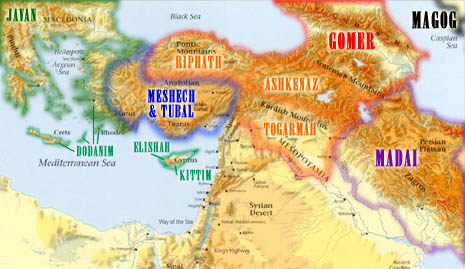
|
|
One possible arrangement of the descendants of Japheth as they initially dispersed after the Flood, according to
Genesis 10:1-5.
Some researchers believe that Meshech and Tubal, two of the sons of Japheth, migrated north over thousands of years into modern Russia and Siberia, their names remembered in the names of the cities of "Moscow", capitol of Russia, and "Tobolsk", a major city of the Siberian region east of Moscow. The classic reference in
Ezekiel 38-39
to the war of Gog and Magog in the end times refers to another son of Japheth, "Magog", as well as a mysterious character, "Gog", who originates from "the land of Magog". Most scholars believe is southeastern Russia, the descendants of Magog being renamed the "Scythians" by the Greeks. Ezekiel prophesied that a confederation of the descendants of Japheth, primarily the descendants of Magog, Meshech and Tubal, would band together to attack the nation of Israel at a future date when a remnant of Israel had been called back from the nations to reinhabit the land of Canaan. Though the prophecy that a remnant of Judah would someday be called back from the nations has been fulfilled, the attack of Gog, Magog, Meshech, Tubal and several other descendants of Japheth upon the restored land of Israel is yet future.
|
 Gomer:
Gomer as a nation is mentioned in
Ezek. 38:6,
and may be identified with the Akkadian Gi-mir-ra-a (the
Cimmerians).
They are a migratory people who made their first historical appearance in western Asia at the end of the 8th century b.c.
Gomer:
Gomer as a nation is mentioned in
Ezek. 38:6,
and may be identified with the Akkadian Gi-mir-ra-a (the
Cimmerians).
They are a migratory people who made their first historical appearance in western Asia at the end of the 8th century b.c.
Ashkenaz:
Ashkenaz represents a people and a country on the upper Euphrates in Armenia. The same name occurs in a passage calling on the kingdoms of Ararat and Minni to rise up against Babylon
(Jer. 51:27).
Again the land of Armenia is pinpointed. Scholars have connected Ashkenaz with the Ashkuza (or Ashkuza/Ishguza) who fought the Assyrians in the reign of Esarhaddon (680-669 b.c.) as allies of the Minni.
Riphath:
Riphath is an enigma. In the light of his brothers that are identifiable, he is probably Anatolian. In
1 Chr. 1:6
"Diphath" occurs, but manuscript evidence fully supports an initial R rather than D here.
Togarmah:
Togarmah exports horses to Tyre
(Ezek. 27:14)
and is in Gog's army
(Ezek. 38:6).
Is he to be connected with Tegarama of Hittite texts and Til garimmu of Assyrian texts? This area is also located near the upper Euphrates in Asia Minor (formerly Togarmah was though to be in Armenia).
 Magog:
The most reasonable identification put forward, in view of of the coupling of Gog and Magog in
Ezekiel 38-39,
is Gyges, king of Lydia.
Lydia
was the ancient designation for western Asia Minor, an ancient kingdom opposite the Aegean Sea from Greece. In Ezekiel Gog and Magog are distinctly belligerent, and the difference between them is not clear.
Magog:
The most reasonable identification put forward, in view of of the coupling of Gog and Magog in
Ezekiel 38-39,
is Gyges, king of Lydia.
Lydia
was the ancient designation for western Asia Minor, an ancient kingdom opposite the Aegean Sea from Greece. In Ezekiel Gog and Magog are distinctly belligerent, and the difference between them is not clear.
 Madai:
Madai is the word used by the OT to designate the
Medes,
a people who inhabited the territory between the upper Tigris River and the Caspian Sea
(
2 Ki. 17:6;
18:11;
Isa. 13:17;
21:2).
They were formidable opponents for the
Assyrians
in the 9th and 8th centuries b.c. Subsequently (late 6th century b.c.) they became partners with the
Persians.
Madai:
Madai is the word used by the OT to designate the
Medes,
a people who inhabited the territory between the upper Tigris River and the Caspian Sea
(
2 Ki. 17:6;
18:11;
Isa. 13:17;
21:2).
They were formidable opponents for the
Assyrians
in the 9th and 8th centuries b.c. Subsequently (late 6th century b.c.) they became partners with the
Persians.
 Javan:
Javan is to be connected with the Hellenic tribal name Ionia, which refers to the western coast of Asia Minor and the Aegean area. Later on (by the Hellenistic period) Javan refers to all Greece. Javanites are merchants trading with the Phoenicians of Tyre
(Ezek. 27:13)
and with Philistines
(Joel 3:6).
Javan:
Javan is to be connected with the Hellenic tribal name Ionia, which refers to the western coast of Asia Minor and the Aegean area. Later on (by the Hellenistic period) Javan refers to all Greece. Javanites are merchants trading with the Phoenicians of Tyre
(Ezek. 27:13)
and with Philistines
(Joel 3:6).
Elishah:
Elishah
is Alashiya, the cuneiform name for the island of Cyprus.
Tarshish:
In the OT Tarshish is identified as a distant port from which silver, iron, tin, lead, ivory, monkeys, and peacocks were exported
(1 Kings 10:22;
Jer. 10:9;
Ezek. 27:12;).
In this table of nations Tarshish could be a Mediterranean port since he is said to be a son of Javan (Greece). Wherever Tarshish is, it was
Jonah's destination in the west
(Jonah 1:3).
Yet
1 Kings 10:22
refers to Solomon's fleet of Tarshish (i.e., larger, seagoing vessels) whose home port was Ezion-Geber, pointing to a route along the Red Sea and the Indian Ocean
(cf.
2 Chr. 9:21
and
1 Kings 22:49,
the latter being a reference to Jehoshaphat's ships of Tarshish sailing for Ophir from Ezion-Geber). Tarshish, then may be reached either by the Mediterranean or by the Indian Ocean, and in either case it is a place reachable only by ship. Most scholars have identified Tarshish with Tartessus, a mining village in southwestern Spain. The name is connected with Akkadian rasasau, "to be smelted", which suggests that Tarshish means "refinery". C.H. Gordon has taken the position that Tarshish was located on the shores of the Atlantic, and could even be Mexico. In a more general way Tarshish may refer to the open sea, to any far-off lands that are reached by oceangoing ships. Furthermore, maintains Gordon, Heb. tarshish may alternatively come from tirosh, "wine", and means "wine-red, wine-dark".
Kittim:
Kittim
is to be equated with Kition, a Phoenician city on the southeast coast of the island of Cyprus near the present city of Larnaka. Kition was a prominent Phoenician base on Cyprus as early as the 9th century b.c. In the Bible Kittim may refer to a land
(Isa. 23:1)
and to islands
(Ezek. 27:6).
Jeremiah
(2:10)
uses the coasts of Kittim as a western geographical pole when he assails the sins of his fellow Judeans. The prophecies of Balaam (see
Num 24:24)
demonstrate that Kittim is a land associated with ships.
Dodanim:
Dodanim
On the basis of the
LXX
and
1 Chr. 1:7,
many commentators have emended Dodanim to Rodanim, perhaps a reference to the island of Rhodes, one of the largest islands of the Aegean, lying off the southwest coast of Turkey. The MT of
Gen. 10:3
can be retained only by the suggestion that both Rodanim and Dodanim came from an original dananim, Gk. danaoi, a people of the Peloponnesus during the Mycenean period. The name may also be the basis for the
"Dardanelles",
the name of a narrow strait in northwestern Turkey connecting the Aegean Sea with the Marmara Sea.
 Tubal:
Tubal may be connected with the Tabali, who were located in eastern Anatolia.
Tubal:
Tubal may be connected with the Tabali, who were located in eastern Anatolia.
 Meshech:
Approximately the same territory covers the descendants of Meshech, the Mushki of the upper Euphrates River.
Meshech:
Approximately the same territory covers the descendants of Meshech, the Mushki of the upper Euphrates River.
 Tiras:
Tiras is to be linked with the Turasha of Egyptian texts, that is, the Tyrrhennians, or later, the Etruscans of Italy.
Tiras:
Tiras is to be linked with the Turasha of Egyptian texts, that is, the Tyrrhennians, or later, the Etruscans of Italy.
That the names given throughout chapter 10 are not exhaustive is borne out by verse 5, which refers to the islands of the nations, unidentifiable but perhaps transoceanic areas.1

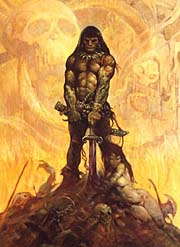
|
|
|
Conan the Cimmerian, as invisaged by legendary sci-fi/fantasy artist
Frank Frazetta.
Robert E. Howard's
"Conan"
character was set in the semi-mythical
"Hyborian"
age, that took place "between the years when the oceans drank Atlantis and the gleaming cities, and in the
years of the rise of the sons of Aryas". In
the movie,
Conan's kinfolk were massacred by the Hyperboreans, probably the ancient Russians,
who were led by a Stygian (proto-Egyptian) sorcerer. In the books, however, Conan left on his own accord, pillaging and plundering
across the ancient world. Though clearly overglorified, Conan's pillaging predilections were an accurate account of his namesake, the
Cimmerians, or "Gomarians" the descendants of Gomer, son of Japheth.
|
|
Though the descendants of Japheth had laid claim to Asia Minor, Syria, Persia, the Caucasus and regions as far east as India and as far west as Spain, famines, changing weather conditions, overhunting, population growth and conflicts with neighboring tribes had forced many of the sons of Japheth to migrate hither and yon in search of greener pastures. Moving from the lands that they had claimed as their own after the Flood, the Japhethites, in contrast to their southern neighbors who were more settled and agrarian, for the most part became nomadic and semi-nomadic shepherds, expanding towards the four winds, primarily north into the vast plains of what is now the Russian steppe in search of grazing fields for their cattle. Though they originally had many kinds of cattle, over time they began to rely more and more on the horse, which could provide them with both transportation and sustenance. Its meat they used to eat, its milk they used to drink, its hide they used to wear, its bones they used for artifice and its sinew they used to string the bow. From this the cult of the horse was born which, along with the chariot, allowed them to conquer their neighbors at will. The usage of these tools of conquest — the horse, the chariot, the bow and the sword — would dominate the destiny of the Japhethite people forever after, even until the time of the end.
Therefore, our map of the Table of Nations is somewhat outdated, as many of the descendants of Japheth had converted from a sedentary existence to a nomadic lifestyle of pillage and plunder, leaving behind their ancestral homelands in the process. However, though many if not most of the ancient ancestors of Japheth had spread to the four winds in search of new lands to conquer, some remained behind to intermarry with the descendants of Shem and Ham in the region, resulting in the existing populations of Turkey, Syria, Armenia, Iran, Afghanistan and other nearby nation-states. And though these nomadic peoples left little in the way of architecture and written documentation, enough historical and ethnographic evidence exists for us to trace where the sons of Japheth eventually settled, evidence which may lead us to some disturbing answers about the histories and final fate of these nations:
 Gomer: The sons of Gomer became known as the "Gomarians", also known as the "Cimmerians". The Gomarians had headed north and west in ancient times, fighting with the descendants of Magog, who had forced them westward, starting a blood feud that continues to this day. The Gomarians entered and settled Europe through what is now Germany and Austria, some of the vowels in their tribal name shortened to become the
"Germans".
Gomer: The sons of Gomer became known as the "Gomarians", also known as the "Cimmerians". The Gomarians had headed north and west in ancient times, fighting with the descendants of Magog, who had forced them westward, starting a blood feud that continues to this day. The Gomarians entered and settled Europe through what is now Germany and Austria, some of the vowels in their tribal name shortened to become the
"Germans".
Ashkenaz: ("Spreading Fire") Ashkenaz is also a Germanic people, possibly the Scandinavians, as some believe that they were known in Europe as the "Scandia". Or, they might be the Slavic peoples. Smith's Bible Dictionary links their name to the term "spreading fire", which reflects well their tendency towards pillage and conquest.2
Riphath: ("Crusher") Little is known about Riphath, except perhaps that they were the ancestors of the
Paphlagonians,
who lived in northern Asia Minor. A river, the "Rhebas", may reflect their original name. Some texts have "Riphath" as "Diphath".3 Another possibility is that Riphath may be the same as
"Rapha",
father of the
Rephaim
giants of the Old Testament, who were believed to have descended from Rapha.
Togarmah: Togarmah is likely also an Indo-European people, typically identified with "Germania" due to its similarity to the pronunciation of the word "Togarma". "Tueton" is also somewhat similar, though the evidence is not strong enough to take a decisive stance on either. Others see the root of the word "Armenia" in Togarmah, though Armenia may have just been the starting point for these wandering peoples. They may also be the Turks.4
|
|

|
|
|
A Parthian horse-archer taking a
"Parthian shot" — the trademark military manuever of the descendants of Magog. The descendants of Magog, the Scythians, as well as the Parthians and other descendants of Japheth who migrated east developed worldviews and techniques of warfare that involved indirect, "harrying" tactics designed to wear down the enemy. This was in diametric opposition to the technique of directly crushing the enemy with overwhelming force, as was the worldview and military method of the western branch of the descendants of Japheth, as best exemplified by the Gomerians (the Cimmerians). In practice, the western Japhethites preferred a straight charge towards the enemy on horseback with a mounted lance or sword, whereas the eastern Japhethites preferred to circle around their enemies with mounted archers and pepper them with bowfire until they retreated or were destroyed. This was most effective on the steppes, where there were vast areas in which to encircle and wear down the enemy, but was much less effective in hilly or heavily forested areas. As a result, the Scythians were able to drive the Cimmerians from the steppes of southern Russia and Central Asia, but were not able to drive them further than hilly and heavily forested Europe, where the Cimmerians had the advantage.
Image from
Iran Chamber Society.
|
 Magog:
Magog's territory in the north and east of the Caucasus places him in southern Russia and the Central Asian republics to the east. In ancient times, the region had been fought over by the Gomarians (q.v.) and the descendants of Magog, who in historic times were referred to by the Greeks as the "Scythians". The later Scythians were a race of superb horsemen and archers, who had forced the Gomarians to emigrate into Europe around 700 b.c., and remained in the region to become the southern Russians and related Central Asian peoples. The Parthians were also likely of or closely related to the descendants of Magog.5
Magog:
Magog's territory in the north and east of the Caucasus places him in southern Russia and the Central Asian republics to the east. In ancient times, the region had been fought over by the Gomarians (q.v.) and the descendants of Magog, who in historic times were referred to by the Greeks as the "Scythians". The later Scythians were a race of superb horsemen and archers, who had forced the Gomarians to emigrate into Europe around 700 b.c., and remained in the region to become the southern Russians and related Central Asian peoples. The Parthians were also likely of or closely related to the descendants of Magog.5
 Madai:
Madai, unlike many of his brethren, led a more settled lifestyle south and west of the Caspian Sea. The sons of Madai formed the ethnic basis, along with Parthian and later Semitic immigrants, of the Persian Empire, which was to be one of the greatest empires of the ancient world. The descendants of Madai still live in and around eastern Iran, Afghanistan, Pakistan, and possibly as far east as India or farther.6
Madai:
Madai, unlike many of his brethren, led a more settled lifestyle south and west of the Caspian Sea. The sons of Madai formed the ethnic basis, along with Parthian and later Semitic immigrants, of the Persian Empire, which was to be one of the greatest empires of the ancient world. The descendants of Madai still live in and around eastern Iran, Afghanistan, Pakistan, and possibly as far east as India or farther.6
 Javan:
Javan also took on a more settled lifestyle, though his descendants may have slaked their wanderlust via the sea instead of by horseback. In the process they became first-class sailors and sea traders with trading networks, some believe, that stretched all over the world. Descendants of Javan, the "Ionans", or "Greeks", settled Greece and the numerous islands in the northern Mediterranean, as well as Italy, Spain, and possibly even further west.7
Javan:
Javan also took on a more settled lifestyle, though his descendants may have slaked their wanderlust via the sea instead of by horseback. In the process they became first-class sailors and sea traders with trading networks, some believe, that stretched all over the world. Descendants of Javan, the "Ionans", or "Greeks", settled Greece and the numerous islands in the northern Mediterranean, as well as Italy, Spain, and possibly even further west.7
Elishah: The descendants of Elishah on Cyprus have likely changed little since their foundation. They may also have been the progenitors of the "Elysians", an ancient Greek-speaking people.8
Tarshish: Tarshish is likely "Tartessos", a port on the southwest coast of Spain, which would likely correspond with Portugal. Some believe, based upon its remote location, that it may have actually been a stopover on the way to the British Isles, Ireland or even the Americas.
Kittim: Kittim's descendants, like those of Elishah, likely have not changed since their foundation on the isle of Cyprus. There has been some speculation that the Kittim may have been related to the "Hittim", or
Hittites,
which had founded a powerful empire in Asia Minor during the second millennium b.c., powerful enough to rival even
Egypt.
Dodanim: These ancient peoples still also reside on Rhodes and probably Crete, Santorini and nearby islands. Some think they may have settled even as far as Malta, and even Sicily. As they were a maritime nation, it is not impossible that they may have sailed as far west as Ireland to become the
Tuatha de danaan.
They may also have been the "Denen", part of the mysterious
"sea peoples"
that came forth from the eastern Mediterranean around 1200 b.c. to terrorize the Hittites, Canaanites and especially the Egyptians. The Denen are believed to be the same as the Danaean Greeks.
 Tubal:
Though Tubal appears to have started out in Asia Minor, like Gomer and Magog's descendants, the descendants of Tubal appear to have had a wanderlust that led them far to the north.
Ezekiel
describes Meschech and Tubal as being far to the north of Israel, and hostile to it, which would place them in modern Russia. Tubal's name is likely remembered in the city of Tobolsk, a major city in Siberia, in eastern Russia.
Tubal:
Though Tubal appears to have started out in Asia Minor, like Gomer and Magog's descendants, the descendants of Tubal appear to have had a wanderlust that led them far to the north.
Ezekiel
describes Meschech and Tubal as being far to the north of Israel, and hostile to it, which would place them in modern Russia. Tubal's name is likely remembered in the city of Tobolsk, a major city in Siberia, in eastern Russia.
 Meshech:
Paired with Tubal in
Ezekiel 38-39,
Meshech also appears to have migrated from Asia Minor along with Tubal to populate the far nothern regions. Known as the "Moschi", they are believed to have intermarried with the Scythians, and settled in what is now western Russia. Meshech is believed by most to be remembered in the name "Moscow", the capitol of Russia.9
Meshech:
Paired with Tubal in
Ezekiel 38-39,
Meshech also appears to have migrated from Asia Minor along with Tubal to populate the far nothern regions. Known as the "Moschi", they are believed to have intermarried with the Scythians, and settled in what is now western Russia. Meshech is believed by most to be remembered in the name "Moscow", the capitol of Russia.9
 Tiras:
The World Book Encyclopedia explains that "The people of Thrace were savage Indo-Europeans, who liked warfare and looting. Tiras was worshipped by his descendants as Thuras, or Thor, the god of thunder."10 As such, the sons of Tiras may have later migrated north to become part of the Scandinavian peoples. They are otherwise alternately associated with the Tyrrenians, Etruscans and Thracians, so at least some of the descendants of Tiras likely became the Italians.
Tiras:
The World Book Encyclopedia explains that "The people of Thrace were savage Indo-Europeans, who liked warfare and looting. Tiras was worshipped by his descendants as Thuras, or Thor, the god of thunder."10 As such, the sons of Tiras may have later migrated north to become part of the Scandinavian peoples. They are otherwise alternately associated with the Tyrrenians, Etruscans and Thracians, so at least some of the descendants of Tiras likely became the Italians.
Thus set, the fortunes of the sons of Japheth played out over thousands of years. Though most were relatively sedentary and civilized, their natural aggressions channeled through productive work and trade, two of the elder sons of Japheth, Gomer and Magog, would start a civil war within the Japhethite family that would drive the destiny of both Europe and Asia for thousands of years.

|
|
|
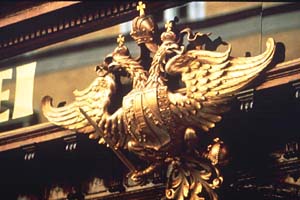
|
|
|
The Austrian Double Eagle was traditionally used to represent the
Habsburg
royal family. The Austrian Double Eagle also shows Teutonic crosses and other emblems used to represent the different ethnic groups and regions under Hapsburg dominion. The sword, orb, and crown are endemic symbols of royal power as decreed by God. The image of the two-headed eagle represents the geographic location of Austria as the center of Europe, indicating that the Habsburg Empire was believed to be sovereign over the whole world, both east and west. The double-headed eagle also stands for aggressive
conquest in general, and may be an ancient fragment of history symbolizing the division of the ancient Japhethites that divided into eastern and western divisions — the Gomarians who moved west into Europe, and the Magogians (Scythians) who moved east, with the intention of eventually conquering and dominating the entire world.
Text adapted from
The History of Austria: The Hapsburgs.
|
|
As we have seen previously but have yet to fully analyze, there is an interesting theme in biblical prophecy regarding two mysterious characters,
"Gog and Magog",
who will have a prominent role in the time of decision at the end of this present age. The first and most prominent mention of Gog and Magog occurs in
Ezekiel 38-39,
where Ezekiel prophesies that, in the end-times, a mysterious "Gog, of the land of Magog, the chief prince of Meshech and Tubal" would be "turned around" and set to attack the land of Israel, which would at that time be resettled by a remnant of Israelites who had returned from the nations to which they had been scattered. This reference, as we have seen, is clearly a reference to the various descendants of Japheth who had migrated to the four winds to settle Europe, Russia, Central Asia and the ancient Near East, including North Africa. However, though Magog, Meshech, Tubal, and other descendants of Japheth have thus far been identified with some certainty, the character of "Gog" has not.
The only other mention of Gog and Magog in the Bible occurs in
Revelation 20:7-10,
where Gog and Magog are described less as distinct people groups than as points on the compass: "When the thousand years are over, Satan will be released from his prison and will go out to deceive the nations in the four corners of the earth — Gog and Magog — to gather them for battle." Here, Gog and Magog are clearly identified with all the nations on Earth and, more important to our study, to the four directions.
A third extrabiblical but very intriguing reference comes from an ancient legend of Gog and Magog which has circulated widely throughout the ancient Near East and central Asia, which goes as such:
Alexander the Great, while conquering the world, came eventually to the Caucasus Mountains where Prometheus the Titan had been chained long before. Here, the Macedonians discovered the evil hordes of Gog and Magog laying waste to the peaceable tribes around them. The country of these wicked raiders lay beyond two great mountains named Ubera Aquilonias, the Breasts of the North. Alexander, calling upon the power of God, moved the mountains together and forged gates of iron and brass to seal the narrow way. These Caspian Gates were further strengthened with a magic metal called asiceton, which was proof against fire and steel; steel shattered upon asiceton, and whatever fires which touched it were instantaneously quenched. And further, Alexander built a mighty wall spanning the entire Caucasus range, closing off the civilized south from the forces of darkness. This wall became known as the Caucasus Wall. But at the end of time, the gates will open and the wall break down, and Gog and Magog will burst forth to destroy the world.11
Gog and Magog have for millennia been considered the ultimate source of evil, the enemies of religion and civilization, and have been particularly closely associated with the battle of Armageddon. But why? They are only mentioned twice in the Bible, the first time only vaguely associated with the battle of Armageddon, and the second time only in passing, as if a footnote, in a time long after the battle of Armageddon has taken place. Yet, "for some reason, 'Gog and Magog' became a nation or nations, with a life of their own, separate from their Biblical source. They passed into the romantic legends of Alexander the Great, which have been rife in Asia since the time of Alexander himself. They appear in the Koran, which has its own version of the Gog and Magog story; from these sources, they spread into common currency and become part of the Old World's travel myths — fables which spread among educated men, during those centuries when most of the earth was still terra incognita."12 These ancient legends consistently identified Gog and Magog as the agents of ultimate evil, whose final appearance heralded the end of this age and the beginning of the Messianic age.
As we have seen,
the symbol of the ancient Kurgans and later Japhethite peoples was
the swastika,
or "sun wheel", which is basically a representation of the four directions, or "the four winds" — the four corners of the Earth. Thus, it is possible that the writer of
Revelation,
when he paralleled the "four corners of the Earth" with Gog and Magog,
was making a clever allusion to the ancient symbol of the swastika, symbolically linking it to Gog and Magog in order to impart to the reader the idea that the descendants of Gog and Magog will spread to the four corners of the Earth again, just as they had done in ancient times. However, though we can begin to see that Gog and Magog are clearly associated with world conquest, and with the cardinal directions, we still need some more information to determine how the equation of world conquest, the four directions, and the destiny of the sons of Japheth will lead us to the identity of the mysterious "Gog".

|
|
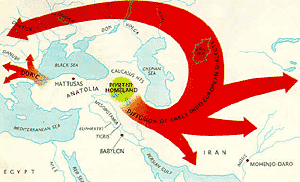
|
|
|
A representation of one possible route of the "Aryan Invasion". The Aryan Invasion Theory posits that a mass migration of peoples took place during the third millennium b.c. and afterwards. One or more waves of Aryan peoples migrated out of the Caucasus region in Central Asia, one half parting from the main body and moving east into Persia, India, and parts unknown to the east, whereas the remaining half continued westward to settle Europe. A third migration likely took place through the Levant, down through Mesopotamia and into Canaan, then west into Asia Minor and from there into southern Europe. This theory is very strongly supported by historical, cultural, linguistic, and genetic evidence, and closely corresponds with our analysis of the re-emergence of the giants in the post-Flood world, whom we believe came forth from the Gomerians and Magogians, who were the prototypical Indo-Aryans.
Image from
Armenian Highland.
|
Migrating to the north of their ancient homelands, the ancient Gomarians and Magogians and related tribes reached the vast, open steppe of southern Russia and Central Asia. Here, around the Caucasus region, according to DeLoach, the Gomerians once again came into contact with the
Nephilim.
At that time, probably around 3000 b.c., the fallen angels began to start breeding giants once more, and had chosen the Gomerians as one of the peoples through whom they would reproduce the giants of the antediluvian world. No doubt the highly aggressive Gomarians were tempted into this abhorrent act through promises of advanced weaponry that would make them invincible against their enemies, as the Gomarians were later known for their technical expertise, particularly in the area of developing weapons and armor.
As we saw in
Part II,
it was theorized that the two fallen angels who had brought ruin to the antediluvian world,
Azazel and Semjaza,
had been imprisoned in or near the Caucasus, and that they were still active in that region. The memory of their imprisonment there was remembered in the Greek legend of the chaining of the titan Prometheus to the Caucasus Mountains, beyond which lay the hordes of Gog and Magog. Prometheus had been chained there by Zeus as punishment for giving man the gift of technology, a gift that would eventually do more harm than good. Similarly, Azazel and Semjaza also had been imprisoned in chains of darkness for giving mankind the gifts of technology, as mentioned in the Book of Enoch and alluded to in
2 Peter 2:4
and
Jude 1:6.
In retrospect, it appears that the Gomerians and the Magogians, passing through that region, had been tempted into a
Faustian deal
with these demons, allowing themselves to be used by them in return for earthly power. As a result, we theorize, the Gomerians and Magogians decided to abandon God and instead worship Azazel and Semjaza respectively, Gomer following Azazel and Magog following Semjaza. In return, Gomer and Magog's descendants began to be specially bred and equipped by these demons into giant warriors with advanced weapons including swords, armor, shields, chariots, and other tools. These weapons, along with the understanding of how to use them, allowed the Gomerians and Magogians to conquer all before them. DeLoach explains,
In these lands, watered by large rivers and described by Strabo as the most agreeable and fruitful parts of all Asia, Gomer's descendants apparently came in contact with the surviving Nephilim and began intermarrying with them. For certain, it was here that the exceptionally tall Gomerians developed into a fierce, warlike people and even fought among themselves over the land. Although these civil wars occurred in the most obscure times, ancient historians have been able to piece together some of what happened. Pezron summarizes what they found, in these words: "This people in process of time increasing to a vast multitude could not always live in repose and tranquility; the seeds of dissentions and jealousies began to spring up amongst themselves: Amid these factions and difficult commmotions, those who proved the weakest either in number or strength, were expelled by the other, and forced to seek for a retreat in the neighboring countries; so that passing over those vast mountains, which are to the south of Margiana, they entered into a country then in possession of the Medes, who were known by the name of Arii. Those fugitives fixed themselves either by force or consent in this country they had made their way to, which was surrounded by high mountains: And as they were a people that had been driven out of their native country, they were called Parthians; the same signifying as much as persons separated from others, exiles or banished people; and it was from this name, which is very ancient, and sticks to them this day, that that province was called Parthia, where these fugitives fixed their habitation.... As for the name Parthians, which the Gomarians gave to those they drove away from among them, it comes, Pezron tells us, from the word Parthu, "which to this very day in the Celtic signifies to divide or separate." These exiled Parthians, out of spite, also stuck a derisive name on their victorious Gomarian cousins. Seeing that they could not otherwise take revenge on them except by abusive language [the original
"Parting Shot"],
they called those giants who drove them off their own land Sacae. In the Celtic, Sacae denotes a thief, robber, or the like.13
Though the descendants of Gog and Magog were being carefully bred and trained by Azazel and Semjaza, it appears that Azazel and Semjaza may not always see eye to eye on how to go about doing things. In fact, it is highly likely that the two are in conflict with each other on who will rule the world, and how it will be ruled. Assuming that the activities of these demons can be measured by observing patterns in history, it may be that Azazel prefers a more direct, linear approach, whereas Semjaza prefers a more indirect, circular approach, both in their general worldviews and in their approaches to warfare and weapons design in particular. This is true because, for as long as records have been kept, the western approach to life and war has been based upon logic, reason, rationalism and linear thought, as typified by Greek philosophy. By contrast, the eastern approach to life and war has been based more upon intuition, introspection and circular "logic", as typified by Eastern philosophy.
|
|
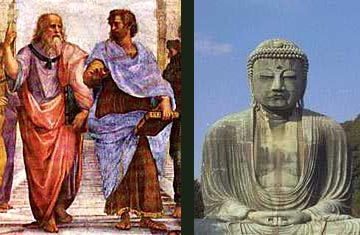
|
|
|
Since time immemorial, a great divide has existed between the eastern and western worldviews, with no apparent reason as to why. Our new
theoretical "Gog and Magog" paradigm suggests that the differences between eastern and western worldviews are spiritual in nature, where
each hemisphere of Earth is ruled over by a spiritual "prince" whose activities are made manifest in the patterns of thought and
living to be found in each hemisphere. According to this theory, the "Prince of the West" employs logic and reason, as typified by the
Greek philosophers Plato and
Aristotle,
where the individual is emphasized over the group.
Conversely, the "Prince of the East" employs intuitive and non-linear methods, as typified by
Buddhism
and Hinduism, religions which tend to denigrate the individual in favor of the group. This theory, though at odds with our modern,
scientific worldview, would have been completely acceptable in the minds of the ancients, who believed that the Earth was indeed ruled
over by a hierarchy of fallen angels. Paul himself even wrote this very thing in
Ephesians 6:4,
and their struggles are clearly elucidated in the
Daniel 10,
where a "Prince of Greece" (western prince) and a Prince of Persia (eastern prince) are clearly identified.
It is our theory that these are the same demon princes, called Azazel and Semjaza in the Book of Enoch, that were placed in chains in darkness just before
the Flood,
as described in
2 Peter 2:4
and
Jude 1:6.
Also, these two demons, like Gog and Magog, will be released at the end of days to wreak havoc upon the world one last time.
|
The difference in the
philosophies
of these two demons, according to our theory, caused a division between the two descendants of Japheth, a division that resulted in one group, the Gomerians, migrating west, whereas the other group, the Magogians, remained in the east to become the Parthians — "ones who were divided off" and related peoples. The Gomerians, who forever after were at war with the Magogian Parthians were eventually driven out of the east by the Parthians and their descendants to populate eastern and central Europe, becoming the Germans, Austrians, and related peoples. Their descendants, the Celts, continued to conquer westward throughout Europe, the British Isles, Ireland, Scandinavia and, as we saw in
Part II,
all the way to the Americas.
|
|
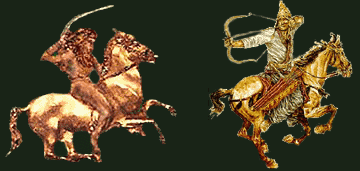
|
|
|
Gog and Magog — the paradigm of history. According to our theoretical West/East paradigm, the descendants of Japheth divided up into two main groups: those who migrated west and followed philosophies of rationalism and logical reasoning, and those who traveled east and followed philosophies of intuition and circular reasoning. These two diametrically opposed philosophies led to diametrically opposed lifestyles and methods of warfare, as typified by the Gomerian (Kurgan) horseman who attacks directly with a sword on horseback, and the Magogian (Parthian) horseman who uses an evasive, passive/aggressive, circular form of attack/defense with the bow. It is interesting to note that, though the
Book of Revelation
does not specifically mention Gog and Magog in relation to the battle of Armageddon, the first horseman is described as riding on a white horse with a bow, like the archetypal Magogian warrior, whereas the second horseman is depicted as riding on a red horse with a sword, like the archetypal Gogian (Gomerian) warrior.
|

|
|
|
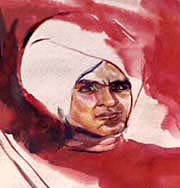
|
|
|
"
Khan Noonian Singh",
a painting done of Khan as he would have appeared on 20th century Earth. In the Star Trek mythos, from 1992-1996, Khan was the absolute ruler of one-quarter of Earth, from Asia to the Middle East. Khan is basically an idealized representation of Magog, the spiritual ruler of the East.
Image from
Star Trek: "Space Seed".
|
|
Meanwhile, the sons of Magog continued to conquer eastward, moving into Iran, Afghanistan, Pakistan, India, and all across Central Asia. From there they moved up through China, leaving behind the Caucasian
"Takla Makan"
mummies, and eventually met up and fought with the Gomerian giants over control of the Americas. Eventually, the descendants of Gomer became the rulers of the western hemisphere, "the West", whereas the sons of Magog became the rulers of the eastern hemisphere, "the East". Together, as Gomer and Magog, apparently shortened for poetic license to "Gog and Magog", they eventually spread across the entire earth, conquering and ruling over native peoples all over the world — Gog ruling the West, and Magog ruling the East. And through them, Azazel extends his influence as "Gog", the spiritual ruler of the western hemisphere, and Semjaza extends his influence as "Magog", the spiritual ruler of the eastern hemisphere, to this day.
Thus, the close connection between the four directions and Gog and Magog in Revelation 21 becomes understandable. The ancient world was not only conceptually divided into four directions, but also into two hemispheres: the West and the East, as it is today. The only difference between now and then is the terminology.
|
|
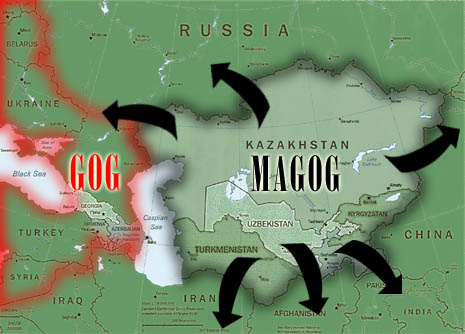
|
|
|
Estimated area of control of Magog, son of Japheth. Magog apparently controlled the area now known as Central Asia, comprised of the current countries of Kazakhstan, Uzbekistan, Turkmenistan, Kyrgyzstan and Tadjikistan. Magog did not stay within his divinely mandated boundary, however, his descendants known throughout the ancient world as pillagers and plunderers. It is likely that the modern "Indo-Aryans" of northern Afghanistan, Pakistan, and northern India are the descendants of Magogian invaders or their allies. Magog also spread into China and northwards, being in control of the Silk Road for thousands of years, and leaving behind numerous tall, Caucasian mummies clad in tartans very similar to that worn by the Celts of Europe. Eventually, the descendants of Magog, the Scythians, gradually wore down and drove Gog (the Gomerians) out of the Caucasus and the steppelands of southern Russia and the Ukraine, forcing them into Europe to become the Celts of Europe.
|
|
|
|
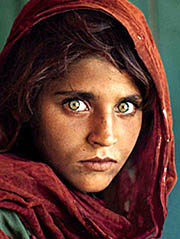
|
|
Sharbat Gula, the famous "Afghan Girl" whose glimmering green eyes captured the world's imagination in the summer of 1985. Recently
rediscovered, Gula is a missing link in our understanding of the influence of Indo-Europeans on the south-central Asian countries of
Afghanistan, Pakistan, and India. Image from
National Geographic.
|
Magog, Prince of the East, after gradually wearing down and forcing the Gomarians to emigrate west, began to expand his philosophy all the way to the islands of Japan
through military conquest, leaving the seeds of what would become Buddhism, Hinduism, Shintoism — what are known today as the Eastern philosophies — in his wake.
Magog's hordes, after driving Gomer's hordes to the west, began to rapidly expand towards the southeast into Iran, Afghanistan, Pakistan, and India, east into China, and to the Americas via the ancient land bridge, leaving giant religious, architectural and cultural footprints in their wake. Remnants of giant peoples and artifacts can even be found as far afield as Australia and New Zealand.
But perhaps the most powerful evidence of Indo-European influence in Asia, over and above the linguistic, cultural and religious evidence, can be found by simply looking at the people. Blonde or red hair, blue or green eyes, great size and strength do occasionally appear in the populations of Iran, Afghanistan, Pakistan, Central Asia, China and especially India, where the "upper caste" has Caucasian features that are quite distinctive. Let us now review the evidence for the penetration of the giants of Magog into the Near, Central and Far East to try to discover what became of the giants of Asia.

|
|
|
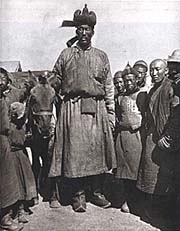
|
|
|
This Mongolian giant was photographed in Ulaanbaatar, the capitol city of Mongolia, in 1922. Assuming even an average height of 5'4" for
his companions, this giant must have towered close to 8 feet tall — truly a giant among the diminutive Mongolians. This man is clearly
one of the original giant descendants of Magog.
Image from
The World of Steve Quayle: Giants and Ancient History.
|
|
As we saw in
Part II,
there is definitive historical, cultural, genetic and linguistic evidence proving that the Indo-Aryan Kurgans had conquered the Americas thousands of years before it was previously believed Europeans had "discovered" the Americas. Even stronger evidence proves that the Indo-Aryans had invaded India, Persia, China, and perhaps even Australia and New Zealand. For example, Indo-European languages are still alive and well all over Europe, Asia, and the Middle East. Just as we discovered in
Part II
that genetic evidence proves that two different branches of the Indo-Europeans, "X1" and "X2", went west and east, two different branches of the Indo-European root language also prove the existence of an east/west division between the ancient sons of Japheth. Though the European branch of Indo-European languages is referred to as
"Centum languages"
and the Asian branch of Indo-European languages is called
"Satem languages",
we will simplify them and refer to them Gomarian and Magogian branches, respectively.
After the sons of Magog had forced the Gomarians off of the steppelands of southern Russia, they turned their mounts eastward and surveyed the vast, rich lands of Asia. Their route was not a direct one, however, as their march of conquest first headed southeast into the vast territories that are known today as Iran, but have been classically known as ancient Persia.

As we saw in
The Table of Nations,
the descendants of Japheth controlled vast areas, including the area southeast of the Caucasus that would later become generally known as "Persia". In more modern times this region has come to be known as Iran, a name derived from the term
"Aryan",
Persian for "lordly" or "noble". It was a term that the ancient Persians used to distinguish themselves from other tribes, whom they considered to be inferior. Madai had been ceded the Persian region after the Flood, and his descendants, the Medes, would come to form the first great empire in that region. They, along with the descendants of Magog, formed the largest group of Indo-European peoples on Earth for many centuries, if not millennia. Basirov explains,
As late as the closing decades of the 4th century B.C., the Iranian peoples were still the largest and the most widespread group within the great Indo-European family; this position must have been held for thousands of years by their nomadic ancestors, and was not relinquished until well into the Roman period; during those distant millennia, they roamed the vast, limitless Eurasian steppes as pastoralist riders and charioteers; towards the end of the second millennium B.C., some of them, lured by the great civilisations of the Indus vally, Elam, Mesopotamia, and Asia Minor, moved southwards and made permanent settlements; it didn't take very long for one group of these settled people, the Medes, to form the first of the four Iranian empires, and less than 500 years for the Persians, to become the absolute masters of the known world; their nomadic ancestors, however, continued to roam the steppes, unopposed, for a very long time.14
Though the sons of Madai were relatively sedentary and civilized, the sons of Magog were not. And the most famous of these sons of Magog were
the Scythians,
who continued to roam the steppe unchallenged even during the time of the mighty Persian empire. The Scythians were unlike the Asiatic Mongols who would dominate the region centuries later, however, being instead a giant, Caucasian race of horse archers, whose average height may have been well over 7 feet. They and their descendants, the Parthians, would militarily dominate the region for centuries.
|
|
|
|
|
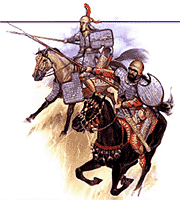
|
|
|
Though the "Scythian Period" in the history of Eastern Europe lasted little more than 400 years, the impression these horsemen made upon the history of their times was such that a thousand years after they had ceased to exist as a sovereign people, their heartland and the territories which they dominated far beyond it continued to be known as "Greater Scythia". From the very beginnings of their emergence on the world scene the Scythians took part in the greatest campaigns of their times, defeating such mighty contemporaries as Assyria, Urartu, Babylonia, Media and Persia. Image from
Scythians 700-300 B.C. (Men at Arms Series, 137)
|
The Scythians were known by the Achaemenians, as SAKA and SKUDRA, by the Greeks, SKYTHIA, by the Romans, SCYTHIAE (pron. SKITYAI), which has given us the English word SCYTHIAN; they lived in a wide area stretching from the south and west of the River Danube to the eastern and northeastern edges of the Taklamakan Desert in China; this vast territory includes now parts of Central Europe, the eastern half of the Balkans, the Ukraine, northern Caucasus, southern Russia, southern Siberia, Central Asia and western China.
We know a great deal about their physical appearance; they were long-headed giants with blond hair and blue eyes; this well-known fact is attested by various classical sources, and by their skeletal and other remains in numerous archaeological excavations, which give a fairly detailed description of these ancient Iranians; recently, a large number of their mummified corpses were discovered in western China; these
mummies,
which are extremely well-preserved in the arid conditions of the Taklamakan desert, are now on display at the museums of Khotan, Urumchi, and Turfan in Sinkiang; they are dressed in Scythian costume, i.e., leather tunic and trousers, and are usually displayed in the sitting position, exactly as described by Herodotus; what is extraordinary apart from their northern European features, however, is their gigantic heights, well over two metres as they are now, in spite of the natural shrinkage expected during the past thousands of years.15
The Scythians were followed in the region by the Parthians who, as we have seen, derived their name from having been split off from the main body of the Gomerian/Magogian horde that had spread northwards over the Caucasus after the Flood. Despite their initial defeat, the Parthians recovered and maintained one of the longest-lasting empires of the ancient world, being able to hold their own even against the Romans. "The Parthians in whose hands the empire of the east now is, having divided the world, as it were, with the Romans, were originally exiles from Scythia. This is apparent from their very name; for in the Scythian language exiles are called Parthi."16 The Parthians were later conquered and assimilated by the
Achaemenid Persians.
The Persian Empire continued on for several centuries, and came to be the largest empire the ancient world had ever seen.
However, though the Persian Empire was defeated by Alexander (the eastern prince conquered by the western prince - cf.
Daniel 10)
the Parthians continued on as a coherent people well after the end of the Persian Empire, thoroughly defeating the Greeks and Romans on more than one occasion and maintaining their life of freedom on the steppes of Central Asia.

|
|
|
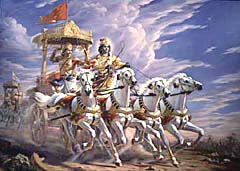
|
|
|
"Vishnu's Chariot". The
Rig Veda
and other ancient texts tell the story of how a giant,
Caucasian,
chariot-riding
race had
invaded
India thousands of years ago, conquering and destroying most of the
aboriginal peoples
who had once lived in northern India. These
invading peoples were referred to as the
"Aryas"
as opposed to the native
"Dravidians"
and other aboriginal peoples.
Though the Aryas initially freely intermarried
with the Dravidians and other native peoples, later movements in religion and society imposed a rigid caste system upon Indian society,
where the descendants of the Indo-Aryans formed a heredity royalty class which still exists today.
|
|
Of all of the countries whose ancient histories were affected by the
Aryan Invasions,
India's history was by far the most impacted by the imperialistic ambitions of the sons of Magog. Not only India's history, but also its language, social structure and even religion had been mightily impacted by the Aryan Invasions, of which apparently there have been many. To this day, modern Indians still hold to lifeways that had been introduced by foreigners from Central Asia who had invaded their country over 4,000 years ago. Riding on their mighty bronze chariots, the invading Indo-Aryans must have seemed like gods to India's aboriginal inhabitants. Accordingly, the Indo-Aryan invasions were immortalized in the Vedas and Suras, the central religious texts of ancient India. In these ancient texts, the giant Caucasian invaders were depicted as "gods" who had founded dynasties of royalty that still, to this day, dominate the rigid caste system of India. However, as we have seen, though the Indo-Europeans were not gods, they were not merely men either, being instead
demigods
— both human and divine. Bred for war and for rulership, these blonde titans carved a bloody path through the ancient world in a vain attempt to slake the interminable thirst of their fallen masters chained in the Caucasus. Giant in size and in thirst for conquest, the giants of Asia invaded and conquered all that their eyes beheld, wreaking great slaughter and exterminating entire cultures in their vain quest to conquer the world. Theertha explains,
More than 4,000 years ago, the Aryas are believed to have come and settled down in the region of the
Punjab
from their original home in middle Asia. Historians get their information about these ancient settlers, or rather invaders, from the
Rig-Veda
which proves beyond doubt that the people who composed those songs had developed a comparatively high civilization. But adventurers who leave their homes for distant countries are not generally the best men of the community, but the lower classes with more physical stamina and animal courage than cultural attainments. The earliest Aryan invaders were no exception to this rule. They were bold, hardy, unscrupulous, superstitious, and even cruel adventurers who were ready to use their powerful right arm against all those who opposed them and to take by force whatever they wanted in the new land to which they came.
It is quite certain that they did not come with a mission, with a sense of their superior culture and a holy desire to civilize the barbarians. Even when they found that many inhabitants of India were less advanced in civilization than themselves, they hardly ever showed any desire to raise them to their own level or to impart to them their refinements. On the contrary their attitude was characterized by haughty exclusiveness and, cruel contempt for the aborigines until they came into contact with a people as civilized as themselves in the Gangetic valley and began to mingle freely with them. The Aryas were essentially a race of warriors. They were lured by the natural wealth and beauty of the country from one place to another and steadily extended their migrations overcoming and sometimes mercilessly extirpating the aborigines who opposed their march, until they were able to settle down in peace and develop powerful kingdoms in the Gangetic valley.17
|
|
|
|
|

|
|
|
Many northern Indians show distinctly Caucasian features. In this image, the woman's features are particularly Caucasian, indicating
some Indo-Aryan ancestry.
|
The Aryan invaders attacked and destroyed everything and everyone in their path, exterminating entire cultures, and forcing the survivors to flee to southern India, where a distinctly separate culture still exists to this day. In the north, however, particularly in the
Indus Valley
region near the border in Pakistan, this ancient Aryan-influenced culture is still clearly evident among the people, including light skin, blue or green eyes, and distinctly Caucasian features. Naidu provides a very thorough listing of all of the Aryan invasions that have taken place over the thousands of years of Indian history in his impressive work,
The Bible of Aryan Invasions:
 Rigvedic Aryan Invasion (1500 BC):
Rigvedic Aryan Invasion (1500 BC):
The First Aryan Invasion involved the annihilation of the Semito-Negroid (Sudra-Panian) Indus Valley civilization by the hordes of
Indra,
and the slaughter of 5 million of its inhabitants. The Indus irrigation system was shattered to permanently destroy agriculture in the region. Sudroid blacks were displaced from all of North India, the survivors retreating to the hill tracts of Bundelkhand-Gondwana.
 Second Aryan Invasion (1400 BC):
Second Aryan Invasion (1400 BC):
Bharata launched the second Aryan invasion from Afghanistan, and conquered much of the upper Ganges valley, defeating the descendants of the first wave of invasions under Indra.
 The Krishnaite (Third) Aryan Invasion (1200 BC):
The Krishnaite (Third) Aryan Invasion (1200 BC):
Krishna launched the third Aryan invasion, invading Western India (Gujarat, Rajastan etc.) from Mathura in Aryavarta. He finally established his capital there, naming it Dwarka. He destroyed the surviving traces of the Indus Valley civilization, abducting and raping 16,000 women
(low-caste
"gopis") of the races he exterminated. Survivals of these acts are found in the much toned-down Krishna-gopi songs.
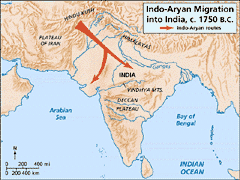
|
|
|
Indo-Aryan Migration into India, c. 1750 B.C.
This map shows the general route taken by the Indo-Aryans who migrated into India beginning around 1750 B.C. They were nomadic warriors who came from the Plateau of Iran and moved through the Hindu Kush Mountains into the Indus Valley and beyond to the Ganges Valley. With them they brought bronze weapons, horses, and chariots.
|
|
 Mahabharatan Aryan Invasion (900-800 BC):
Mahabharatan Aryan Invasion (900-800 BC):
The Fourth Aryan Invasion occurred in 2 parts: First, the Digvijay Aryan invasions that led to the subjugation of all of India to the Aryan yoke. The revolt by the non-Aryans and mixed races led to the terrible
Mahabharatan War
between the Aryan
Pandavas
on one side and the mixed race
Kauravas
and black aboriginals on the other. The Aryan victory enabled them to invade & settle in the Ganges valley and confirmed Aryan dominance. The genocides of this war permanently changed the racial composition of India. These conflicts were some of the most terrible recorded.
 Fifth (Solar) Aryan Invasion (800 BC):
Fifth (Solar) Aryan Invasion (800 BC):
The Fifth Aryan invasion is named Solar, since the Aryans who invaded India during this epoch were of the Solar race (Suryavamsi), while the earlier Aryans were of
Lunar race
(Chandravamsi). Kashyap (ie. from the Caspian) is the progenitor of the Solar race of kings. From the Caspian they swept down into India, driving the preceding peoples before them. Ikshvaku established his chiefdom at Ayodhya, while his grandson Mithi conquered Mithila (named after him). Parasurama continued the 5th Aryan invasion, exterminating various aboriginal races.
 Ramaite Aryan Invasion & Dravidian Holocaust (600 BC):
Ramaite Aryan Invasion & Dravidian Holocaust (600 BC):
The 6th Aryan invasion of the deep South (Dravidia) by the armies of "Lord" Ram led to the fall of the Rakshasa (Dravidian) empire & the destruction of the splendid city of Ravana. The apartheid varna system was imposed, with those black Dravidian Sudras who accepted Aryan enslavement being relegated to the `Clean Sudra' caste , while those who fought the Aryans were relegated to the `Untouchable Sudra' castes ("panchama") of Dalits and Adivasis. The worship of the Aryan religion of Vaishnavism was introduced, and most Dravidians in Lanka exterminated.
 Buddhist Aryan Invasion (260 BC):
Buddhist Aryan Invasion (260 BC):
This Seventh Aryan invasion was launched by Askoka, King of Aryan Magadha. His attack on Kolarian Kalinga led to the horrible Kalinga War, in which 200,000 black aboriginals were killed & countless more enslaved. Several wars with the aboriginal races were waged. The Aryanised religions of Jainism and Buddhism entered South India. Although these religions were liberal with Aryan castes, and Buddha was in fact a Mongoloid, these faiths kept the fundamental Aryan-Sudroid apartheid varna system. The Aryan Sinhalese Buddhists, invading from East India, meanwhile, exterminated the entire population of native black Dravidoids. Staunch Buddhist fanatics, they destroyed scores of Shaiva shrines, erecting Buddhist temples on the ruins and eventually eradicating Shaivism from Lanka.
 Eighth Aryan Invasion (100 BC):
Eighth Aryan Invasion (100 BC):
The Eighth Aryan Invasion occurred under the Maharashtrian Satavahanas. They invaded Dravidia, sacking several cities and annexing Dravidian lands. This was the first of the Maharasthrian Aryan Invasions.
 Nineth (Guptan) Aryan Invasion (250 AD):
Nineth (Guptan) Aryan Invasion (250 AD):
Samudra Gupta of the Gupta dynasty in Aryavarta invaded south India and conquered several non-Aryan nations. The famous invasion of Daskhinapatha led to the subjugation of many native Indian races, incl. Tamil Nadu. This led to a hardening of the varna system even in remote areas. Several wars with the Scythians were also waged.
 Rajput (Scythic) Aryan Invasion (300 AD - 1400 AD):
Rajput (Scythic) Aryan Invasion (300 AD - 1400 AD):
The Rajputs are descendants of Scyths, Greeks, Kushans, Romans, etc. who entered India mostly after the fall of Guptan Koshala. Finding Aryavarta (Braj-Koshala) dominated by Aryans, they entered Rajastan and over several centuries, annihilated the Black Abroginal population of Bhils & Minas.
 Eleventh Aryan Invasion (600 - 1000 AD):
Eleventh Aryan Invasion (600 - 1000 AD):
This occurred under the Maharashtrian Chalukyas, and is also known as the Second Maharasthrian Aryan Invasion. During these wars, Pulkesin II (610 - 642) conquered several Dravidian peoples, and invaded Tamil Nadu. Finally, after severe persecution of Dravidians, a wave of revolt by the Dravidian Shaivite Lingayats destroyed Aryan Chalukya rule.
 Vijayanagaran Aryan Invasion (1336-1646):
Vijayanagaran Aryan Invasion (1336-1646):
The semi-Aryanized Andhras embarked on one of the most systematic subjugations of the Dravidian races on record. The entire epoch of the dark Vijayanagar empire was one of conquest, oppression, and mass murder of Dravidians. In the Apartheid Andhrite Vijayanagar varna system, a semi-Aryan Mulatto Nair warrior would shoot a Dravidian Sudra Negro at sight.
 Oriya Aryan Invasion (1450-60 AD):
Oriya Aryan Invasion (1450-60 AD):
Kapilendradeva of Indo-Aryan Orissa invaded the Dravidian nations in the 1450s-60s, conquering the Reddi kingdom of Vengi and pillaging his way deep into Tamil Nadu.
 Mughal Caliphate of Islam:
Mughal Caliphate of Islam:
The Mughal Caliphate of Delhi in Hindustan (North India) meant the end of the apartheid varna system in the north. Sudra Blacks could re-enter civilization, and contributed much to Mughalstani (Indo-Islamic) civilization as warriors, miners, agricultural labour, police, etc. The varna apartheid system remained in force in Dravida Nadu (South India), however. Here the Aryan Brahmins collaborated with the Aryan Islamic invaders from Central Asia and maintained this inhuman institution.
 Marathan (Thirteenth) Aryan Invasion (18th century):
Marathan (Thirteenth) Aryan Invasion (18th century):
The barbaric Marathas launched the fourteenth Aryan invasion. All Dravidian nations were subjugated to the Aryan yoke once again. Blacks were subject to severe oppression, eg. the Peshwa rulers forced the Dalits in Maharashtra to carry pots to hold their own spittle and brooms to wipe away their footsteps as they walked.
|
|
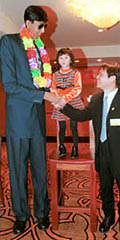
|
|
|
Naseer Ahmaad Soomro, born in Pakistan in 1970.
Naseer's exceptional height — apparently over 8 feet tall — and Pakistani origin makes him a clear candidate to be a descendant of
the ancient Indo-Aryan giants. Image from
The World of Steve Quayle: Giants in Recent Times.
|
 European Aryan Invasions (1500s-1947):
European Aryan Invasions (1500s-1947):
With the help of the Aryan Brahmans, the Portuguese Aryan invaders managed to conquer Malabar. The Portuguese allowed their white cousins to maintain the apartheid varna system of Manu in most of Malabar, and even adopted some of its features in Goa. The Aryan Anglo-Saxon invaders were also supported by the Indo-Aryans, especially the Brahmans (cf. RSS never opposed the English, Congress supported the English in World War I, etc.). The kindred Aryan civilizations adopted much from each other, eg. the Theosophical Society, etc., but combined in their suppression of Black Sudra civilization.
 Republic of India (1947 ->):
Republic of India (1947 ->):
The Republic of India officially perpetrated the pro-Aryan government of the English. Thus, Sudra Religion (Saivism) is not recognised as a separate religion, but they are classed, along with all Sudra Blacks, as (Aryan) Hindus. It has been shown that they are not the Hindus. This was mainly due to the racist anti-Sudra M.K.Gandhi, who prevented the British, and later the Indian Government from enacting such legislation. `Khari Boli' Hindi, heavily Sanskritised, is, along with English, the co-official language of India, and is expanding rapidly at the expense of Dravidian tongues.18
India's history, then, was basically a litany of invasions by a people who, though civilized, behaved like barbarians. It is interesting to note that the invading Indo-Europeans, though they considered the natives to be inferior, for a time still took wives of whomever they wished, much like the giants of the antediluvian world had done. And though the blonde giant invaders of millennia past are no longer to be found in India, their legacy still lives on in the occasional exceptionally tall Indian boy, and the shimmering blue-green eyes of
Bollywood
starlets.

|
This mummy was one of many found in the Takla Makan desert in central Asia, in the far northwestern corner of China.
Though many mummies have had typical Asian features, this and many more displayed distinctly European features. This ancient beauty forms a
link to a part of humanity's ancient past that had previously been forgotten. Image from
NOVA Online.
|
Secreted away in the sands of the Takla Makan desert in northwest China are the remnants of an ancient civilization previously unknown to mankind. This civilization was not distinguished by its riches, power or military prowess, but by its incongruity.
Surrounded on the north by the Tien Shan mountains � beyond which lies vast Khazakhstan � on the west by Kyrgyzstan and Tajikistan, on the south by Pakistan, and on the east by central China (see
map),
the Takla Makan mummies should be ethnically either Asiatic, Arabic or, more likely, a combination of the two. These mummies, however, are neither ethnically Asiatic nor Arabic, but distinctly European, both in dress and in appearance.
When Sir Aurel Stein found the first group of mummies near the city of Loulan in 1906, they were dressed in woolen garments, and wore hats made of felt that were festooned with jaunty feathers. Upon further examination, it was also discovered that these mummies had facial and body characteristics that were clearly European, including high cheekbones, blond or red hair, facial hair on the men, and a height and stature typical of northern Europeans.
Theorists believe that these were Celtic European settlers who, in the ancient past, had once presided over the central Asian silk trade � specifically, the famous "Silk Road", through which vast amounts of silk and other exotic goods from China were once carried to Europe. This road, which has long since fallen into disuse in favor of overseas trade, once spanned the vast deserts and steppelands of central Asia, and has been the setting for many stories, legends and international intrigues, both in Asia and in Europe, for many centuries. Though it is not known why they disappeared, some of the mummies suggest evidence of violence, perhaps due to conquest by another people or, some speculate, ritual sacrifice.
Though these mummies have been found scattered around the valley of the Tarim river that bisects this vast desert, the oldest groups of mummies have come from the cities of Cherchen, where mummies date as far back as 1000 b.c., and Loulan, where they date as far back as 2000 b.c. The best preserved mummies were those that were buried in the sandy desert in the wintertime, in open-bottomed coffins that allowed the cold, salty sand of the Takla Makan desert to quickly freeze dry their bodies. Some of the mummies wore beautiful silk wraps that, in appearance, look almost fresh from the loom, whereas others, particularly the Celtic types, were buried in colorful tartan fabrics that closely resemble European fabrics of the same period.
These fabrics, as well as the clearly European features of many of the mummies, have led many scientists to the inescapable conclusion that a previously unknown civilization once thrived in along the Tarim river in the midst of the vast Takla Makan. This civilization once may have been vast, spanning the central Asian region, but only that part of it that spanned the Takla Makan is now remembered, due to the incredible preservative properties of its salty sands that preserved enough of this ancient civilization to bring it to remembrance. The Takla Makan mummies, also known as the "Urumchi Mummies", are currently on display in the Provincial Museum of �r�mchi.
|
|

|
|
|
Chang, the Chinese Giant
(Chang Woo Gow, c.1845-1893)
�Chang, the "Chinese Giant," first came to England in 1864, being at that time nineteen years old and 7ft. 9in. high. Chang returned to his native Pekin until 1878, when he went to Paris for the Exhibition. By this time he had grown both taller and stouter, and his height was a trifle over 8ft., while he weighed 26st. (365 pounds). After his retirement into private life Chang resided at Bournemouth, England where he died at the age of forty-eight.
Text and image from
Footlight Notes
|
Not surprisingly, China too has a tradition of giants. Numerous invasions from the west into China had had an effect just as dramatic on Chinese history and culture as they had had on that of India. Moreover, intermarriage between the Chinese people and the invading giants no doubt had an effect on the Chinese genome, which tales of Chinese giants in times past prove. DeLoach explains,
The Chinese, in whose land archaeologists have found some of the earliest skeletal remains of giants, insist they once had among them some men as much as fifteen feet tall. We could dismiss this as just another tall tale, except that Melchior Nunnez, in his letters from India, vouches for the fact that China grew some giants to that tremendous size. He "speaks of porters who guarded the gates of Peking who were of that immense height; and in a letter dated in 1555, he avers that the emperor of that country entertained and fed five hundred such men for archers of his guard. They were still there to be seen seventy years later, for George Hakewill, in his Apologie., 1627, issues a similar report.19
This ancient civilization that presided over trade between the west and the east for thousands of years fits perfectly into our emerging understanding of the Caucasian conquerers who had emanated from the Caucasus. Wave after wave of gigantic Caucasian barbarians rode forth on their horses and chariots conquering, and to conquer in all four directions, primarily east and west, only to be assimilated into the smaller but more numerous homo sapiens that dominated the east. Now, the Takla Makan mummies rise as a reminder to the true history of Central Asia, of the ancient conquerors, traders and world explorers that once dominated all Eurasia.

As the sons of Magog spread all over Asia, it may be that, when they had reached the shores of the Pacific, they lusted to conquer its far-flung, exotic isles. And the greatest of these faraway isles was the mysterious continent of Australia. Recently, supporting this possibility, giant artifacts have been uncovered that reveal an unknown past when giants once stalked the Outback. The leader in this field of research is one
Rex Gilroy,
well known in Australia as a leader in the field of
Yowie
research. Rex's belief that the
aborigines
were not the first peoples to live in Australia caused him to set out in the 1960s to begin a more thorough research the very earliest ages of man on this long-forgotten continent.
As an open-minded field researcher of Australia's ancient past and 'unexplained' mysteries generally, I have never been able to accept the 'traditional' view that the first stone-age inhabitants of Australia were the Aborigines.
Spurred on by this belief, in the mid-1960's I began an extensive field investigation in search of supportive evidence for my theory. After a three year search I stumbled upon an extinct Pleistocene [ice age] course of the Macquarie river near Bathurst, in central western New South Wales.
Projecting from a former bank of this river at one site, I discovered numbers of massive stone implements; hand-axes, clubs, adzes, knives, hammer-stones and other tools, ranging in weights of from 5.5 to 16.5 kg.
Such huge 'megatools' could only have been made and used by hominids of immense stature and strength. I afterwards learnt of local Aboriginal traditions of a race of giant men and women, the 'Jogungs', who stood twice the height of a normal human, and who once roamed central western New South Wales.
In the years ahead I recovered further 'megatools' at other locations around Bathurst, while other have also been recovered at sites in northern New south Wales and central Queensland. The most recent megatool is a monstrous 'chopper' made of basalt, it weighs 20 kg, having been found by me near Nundle, south-east of Tamworth, in the New England district of northern New South Wales.
|
|
|
|
|
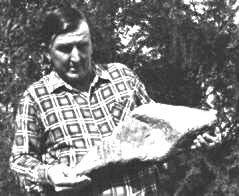
|
|
|
Giant stone
adze
made of basalt, found in
New South Wales,
Australia. As the head alone weighs over 20 pounds, his tool is far to large to be of any practical use to anyone less than twice
the size (and several times stronger) than the typical homo sapiens.
Image from
Mysterious Australia.
|
It is the largest and heaviest megatool I have so far discovered. The former tribespeople of this region believed in a race of giant man-like beings called "Wolumbin", that roamed the earth in the long-ago 'dreamtime'.
But who were these giant toolmakers? Massive fossilised jaws and teeth, dating back 500,000 years have been excavated by archaeologists in Java and China, which anthropologists have named Meganthropus palaeojavanicus, the "Giant Java Man", a race of hominids of around three metres height, and of immense strength, weighing around several hundred kilograms.20
Interestingly, Gilroy points out that fossilized jawbones found in
New South Wales,
Australia match closely fossils of Meganthropus palaeojavanicus,
the so called
"Java Man"
believed to have lived in Java and China over half a million years ago. In fact, according to Gilroy, aboriginal traditions state that a race of light-skinned people, among whom were mingled giants, actually lived in Australia before the ancestors of the aboriginals had arrived.
Aboriginal traditions include references to a white-skinned race which inhabited Australia before them. They also know of a race of giants. During the 1960's I uncovered a culture of giant-sized stone implements in the New South Wales central west. They included hand-axes, clubs, knives, adzes and other tools ranging in weights of from 5 and a half kilograms to 16 and a half kilograms. Such huge "Megatools" could only have been made and used by beings of immense stature and strength.
These implements are reminiscent of others found in Java, where Meganthropus, the "giant Java Man", lived during the last ice-age at least 500,000 years ago, whose huge fossil jaws and teeth suggest creatures of immense weight, who stood up to three times the height of modern man. Did Meganthropus or a close relative of him once roam Australia? Giant-sized man-like fossil footprints, preserved in mudstone, have turned up all over Australia. They include examples found near Kempsey in northern New South Wales up to 50 cm in length by 37 cm width across the toes; and as much as 60 cm length by 25 cm or more in width.21
Interestingly, just as it was in
ancient Canaan,
there may have been in Australia's very ancient past a race of tall, light-skinned people among whom roamed giants anywhere from twelve to eighteen feet tall. Moreover, the linkage between Chinese and Australian giant skeletal remains may indeed mean that the sons of Magog mave have reached even unto the shores of Australia in ancient times.

|
|
|

|
|
|
Martin Doutre believes that New Zealand may have been first inhabited by a people related to the Celts, who have left Celtic-type
artifacts all over the island. Moreover, the native Maori inhabitants speak of an ancient race of tall, light-skinned people with European
features and even red hair, some of whom were of gigantic stature.
Image from
Ancient Celtic New Zealand.
|
|
Finally, we reach
New Zealand,
which some believe may have once been inhabited by a people much like the Celts of Europe. Like the aboriginal Australians, the Maori of New Zealand describe various immigrant peoples with light complexions, hooked noses, and even red hair. Some researchers have theorized that these descriptions refer to various northern European and Mediterranean maritime peoples such as the Milesians, Celts, and even the fabled Tuatha de Danaan of Irish legend. As Martin Doutre explains in his seminal work,
Ancient Celtic New Zealand,
The ordinary stature Turehu could well have been the "Tuatha de Danaan", "Milesians" or later "Celts", as these people ranged from average to very impressive physical stature and all shared a common ancestry. Celtic folklore, referring to the Tuatha de Danaan, describes them as virtual demigods, of magnificent physique and towering height. Similar descriptions are given of skeletal remains in New Zealand burial caves, with some skeletons, reportedly, laid out in body armour. Other burial caves, in the Hokianga district, contain mummified remains..... As stated, a range of other Maori names are also used to describe those light complexioned people, some with strongly hooked noses, from whom integrating, pre-warrior immigrant Polynesians learned weaving, fishnet making carving, astronomy, agricultural techniques, canoe building and a myriad of other advanced cultural expressions. Another distinct group of pre-Maori people are described as being tall, with red hair, some with quite rounded faces and "hooded eyes".22
Based upon the ethnographic descriptions, it appears that New Zealand had been visited by a number of different peoples in ancient times. Mineral rich New Zealand, like Australia, would have been a desirable trade destination, and some believe that it may actually have been visited by such seafaring peoples as the Phoenicians the Egyptians, or even the Israelites during the time of Solomon. Perhaps most interesting to our present study is the description of a tall, red-haired, round-faced people with "hooded eyes". That is a good description of how the offspring of Caucasian giants and Asiatics would look. The giants had intermarried with the mainland Chinese whom they had conquered, and their offspring had apparently continued their forefathers' conquests on into the South Pacific.
Not surprisingly, based upon our analysis in
Giants of the Americas,
both Australia and New Zealand are busy covering up their giant past, even destroying precious truth in order to "protect" us from it. Doutre explains,
|
|
|
|
|
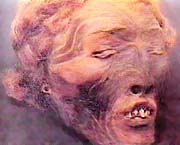
|
|
|
The mummified head of a red-headed Maori. Such a head was likely used for barter for goods, and is proof of Caucasian influence
in New Zealand in ancient times.
Image from
Ancient Celtic New Zealand.
|
The eradication of archaeological sites & artifacts is most certainly going on in the Australia/ New Zealand region, where "concealment teams" are being employed to both destroy or seal away from sight any traces of anomalous discoveries. In the last few years the New Zealand teams have removed/buried/concealed: A trilithon/obelisk arrangement, composed of about 5 component sets, from the Wairaki area of New Zealand's central North Island. The "Artiamuri Stones", registered by Captain Mair in the 1800's and described by him as the 2nd most significant site he'd seen in New Zealand...these were, seemingly, pushed into a river by a "Forestry Department" bulldozer. A number of burial caves containing large stature skeletons with red, brown & blond hair. These skeletal remains are a most unwelcome find, as the ancient individuals were very definitely of Indo-European ethnic origin. Platted samples of their red or brown hair used to be on display at the Auckland Museum...but have long since been removed from public scrutiny. An ancient stone jetty on a northern river estuary. A beautifully hollowed out and fashioned communal dwelling/ assembly area in a limestone cliff. This was at Castlehill in New Zealand's South Island. A friend who revisited it in recent weeks found that the entranceway had been collapsed...undoubtedly by explosives. These few examples represent some of the skullduggery going on, officially, to throw a spanner in the works of normal scholastic pursuit within the confines of New Zealand. A gentleman named Tristan Rankin, who runs the Australian web site:
http://www.awarenessquest.com
complains about similar clandestine, insidious "concealment team" interference in Australian archaeological endeavors.23
Once again, it becomes clear that there is an ongoing, purposeful attempt to cover up the "mistakes" of the past, to protect us from a truth that some believe that we cannot handle. The facts are clear, however, that an ancient race of Caucasian giants had emanated from the Caucasus in ancient times and had conquered all of Asia, island hopped through the South Pacific, and eventually ended up in the
Americas.
These giant, blond sons of Magog and related peoples had spread out from Central Asia in ancient times in several waves of conquest, leaving giant religious, cultural, and archaeological footprints all over Asia.
And though the rage of these demigods crashed like tsunami upon the shores of mankind, wreaking great death and destruction wherever their massive feet tread, they wore down but never destroyed meek homo sapiens who, in the end, inherited the Earth. 

The search for the giants of Asia must begin in the homeland of the giants, the Caucasus. Mt. Ararat, the most likely landing place of Noah's ark, from which spread the sons of Japheth, is located in
Armenia,
a former Soviet republic. Armenia currently does not have an American consulate, and tourism to Armenia is not advised at this time. Moreover,
the former Soviet republic of
Georgia
and
the Caucasus Mountains
are only recommended for experienced travelers, as they too have hot spots and areas of instability.
Iran
is obviously out of the question at this time. Better to visit the homelands of Magog directly, the
Central Asian republics
and travel the old
Silk Road,
though this destination is also best for the hardy traveler.
More accessible destinations include
China,
India,
and of course
Australia
and
New Zealand,
all of which are probable stomping grounds for the giant sons of Magog. If you come across evidence for giants of Asia while exploring the exotic East, take pictures and careful documentation and do not disturb the find or try to take home souvenirs — in some countries that could result in heavy fines or worse. Report the find with your documentation, and we will publish your findings and give you credit in future issues of Mysterious World.
 Noah'sArkSearch.com
Noah'sArkSearch.com
 Russia.com
Russia.com
 Travel In Russia
Travel In Russia
 Travel In Russia: The Caucasus
Travel In Russia: The Caucasus
 VisitRussia.com
VisitRussia.com
 Russia Travel Guide
Russia Travel Guide
 Go To Russia
Go To Russia
 Lonely Planet: Russia
Lonely Planet: Russia

 Travel-India.com
Travel-India.com
 UnveilIndia.com
UnveilIndia.com
 Rajasthan Unlimited
Rajasthan Unlimited
 National Museum of India, New Delhi
National Museum of India, New Delhi
 Madhya Pradesh State Tourism
Madhya Pradesh State Tourism

 CentralAsiaTravel.com
CentralAsiaTravel.com
 The Silkroad Foundation
The Silkroad Foundation
 Following Ancient Footprints: Exploring the Northern Silk Road
Following Ancient Footprints: Exploring the Northern Silk Road
 Travel Concepts International, Inc.: China Silk Road Expedition
Travel Concepts International, Inc.: China Silk Road Expedition
 ChinaWestTour.net: Urumchi-Turpan-Kashi 8-day tour
ChinaWestTour.net: Urumchi-Turpan-Kashi 8-day tour
 Travel China Guide: Tianchi Lake
Travel China Guide: Tianchi Lake
 China National Tourism Association
China National Tourism Association
 Travel China Guide
Travel China Guide
 China Travel Service
China Travel Service
 BeijingTrip.com
BeijingTrip.com
 Imperial Tours
Imperial Tours
 Silkroad Foundation: Urumchi
Silkroad Foundation: Urumchi
 Golden Bridge International Tours: Across the Takla Makan
Golden Bridge International Tours: Across the Takla Makan

 Australian Tourism Commission
Australian Tourism Commission
 Australian Travel Emporium
Australian Travel Emporium
 Walkabout - The Australian Travel Guide
Walkabout - The Australian Travel Guide

 100% Pure New Zealand
100% Pure New Zealand
 Jason's: New Zealand
Jason's: New Zealand
 New South Wales, Australia
New South Wales, Australia
Part I: Giants of the ANE
|
Part II: Giants of the Americas
|
Part IV: Giants of Europe
The Table of Nations
|
The Wars of Gog and Magog
|
Magog, Prince of the East
Giants of Asia
|
Giant Links
|
Giant Books
|
Audio
|
Video
|
Posters
Editorial
|
Press Releases
|
Book Reviews
|
Fragments
Grand Canyon I
|
Giants III
|
Osiria III
Register
for our new Hall of Records Newsletter!
Questions? Comments? Suggestions? Advertising? Press Releases?
Contact us!

1
Adapted from Victor P. Hamilton, The New International Commentary on the Old Testament: The Book of Genesis Chapters 1-17
(Grand Rapids: Eerdmans, 1990), 332-334.
2
Smith's Bible Dictionary, "Ashkenaz"
(Search Works: http://www.reference-guides.com/smiths_bible_dictionary/).
3
International Standard Bible Encyclopedia, "Riphath"
(Bible Tools: http://bibletools.org).
4
Marcus Jastrow, "Ashkenaz"
(JewishEncyclopedia.com: http://www.jewishencyclopedia.com).
5
Silkroad Foundation, "The Scythians"
(Silkroad Foundation: http://www.silk-road.com).
6
Richard Gottheil, "Media"
(JewishEncyclopedia.com: http://www.jewishencyclopedia.com).
7
Richard Gottheil, "Javan"
(JewishEncyclopedia.com: http://www.jewishencyclopedia.com).
8
Harold Hunt and Russell Grigg , "The sixteen Grandsons of Noah"
(Answers in Genesis: http://www.answersingenesis.org).
9
WebBible Encyclopedia, "Meshech"
(JewishEncyclopedia.com: http://christiananswers.net).
10
Harold Hunt and Russell Grigg , "The sixteen Grandsons of Noah"
(Answers in Genesis: http://www.answersingenesis.org).
11
Sylvia Volk, ed., "The Legend of Gog and Magog"
(Page of Myths: http://www.iras.ucalgary.ca/~volk/sylvia/Myths.htm).
12
Volk, "The Legend of Gog and Magog".
13
Charles DeLoach,
Giants: A Reference Guide from History, the Bible and Recorded Legend
(Metuchen, NJ: The Scarecrow Press, 1995), 131-132.
14
Dr. Oric Basirov, "The Origin of the Pre-Iranian Peoples"
(Circle of Ancient Iranian Studies at the School of Oriental & African Studies (SOAS), University of London: http://home.btconnect.com/CAIS/).
15
Basirov, "The Origin of the Pre-Iranian Peoples".
16
"A Roman Description of the Parthians or Later Persians from Justin's History of the World"
(Sam Houston State University: http://www.shsu.edu/).
17
Swami Dharma Theertha, "The Aryas, the Aborigines and the Indians"
(Dalitstan Organization: http://www.dalitstan.org/).
18
Prof. Uthaya Naidu, "The Bible of Aryan Invasions"
(Dalitstan Organization: http://www.dalitstan.org/).
19
DeLoach,
Giants, 63-64.
20
Rex Gilroy, "Giants of the Dreamtime"
(Mysterious Australia: http://www.internetezy.com.au/~mj129/).
21
Rex Gilroy, "Australia The Cradle Of Civilisation"
(Mysterious Australia: http://www.internetezy.com.au/~mj129/).
22
Martin Doutre,
Ancient Celtic New Zealand (Auckland, New Zealand: De Danaan Publishers, 1999), 55.
23
Martin Doutre, "Forbidden History - Covered Up Again!"
(ViewZone Magazine: http://www.viewzone.com).





 SilkRoad.com: Silk Road Chronology
SilkRoad.com: Silk Road Chronology
 The Cimmerians
The Cimmerians
 Livius: Cimmerians
Livius: Cimmerians
 Livius: Scythians/Sacae
Livius: Scythians/Sacae
 SilkRoad.com: The Scythians
SilkRoad.com: The Scythians
 SilkRoad.com: The White Huns - The Hephthalites
SilkRoad.com: The White Huns - The Hephthalites
 Livius: Arians
Livius: Arians
 Tobolsk, CIS And Baltic Political Geography
Tobolsk, CIS And Baltic Political Geography
 Wikipedia: Kurgan
Wikipedia: Kurgan
 Proto-Indo-European and Indo-Europeans
Proto-Indo-European and Indo-Europeans
 Indo-European Language Tree: Centum Languages (Western/X1 Branch)
Indo-European Language Tree: Centum Languages (Western/X1 Branch)
 Indo-European Language Tree: Satem Languages (Eastern/X2 Branch)
Indo-European Language Tree: Satem Languages (Eastern/X2 Branch)
 A. Richard Diebold Center for Indo-European Language and Culture
A. Richard Diebold Center for Indo-European Language and Culture
 A. Richard Diebold Center for Indo-European Language and Culture: The Indo-European Language Family
A. Richard Diebold Center for Indo-European Language and Culture: The Indo-European Language Family
 The Early History of Indo-European Languages
The Early History of Indo-European Languages
 The Rosetta Project: Indo-European Languages
The Rosetta Project: Indo-European Languages

 Gog and Magog
Gog and Magog
 The Legend of Gog and Magog
The Legend of Gog and Magog
 Gog and Magog
Gog and Magog
 Chuck Missler: "The Magog Identity"
Chuck Missler: "The Magog Identity"
 AC Russia Invades Israel
AC Russia Invades Israel


 A Roman description of the Parthians or later Persians from Justin's History of the World
A Roman description of the Parthians or later Persians from Justin's History of the World
 Livius: Parthia
Livius: Parthia
 Livius: Parthian Empire
Livius: Parthian Empire
 Livius: Parthian Kings
Livius: Parthian Kings
 Livius: Arians
Livius: Arians
 Livius: Achaemenids
Livius: Achaemenids
 Livius: Cyrus
Livius: Cyrus
 Circle of Ancient Iranian Studies at the School of Oriental & African Studies (SOAS), University of London
Circle of Ancient Iranian Studies at the School of Oriental & African Studies (SOAS), University of London
 The Assyrian King List
The Assyrian King List
 Mesopotamian King List 2800�500 b.c.
Mesopotamian King List 2800�500 b.c.
 Crystal Links: Sumerian Timeline
Crystal Links: Sumerian Timeline
 Sargon
Sargon
 The Legend of Sargon
The Legend of Sargon
 Sargon of Akkad
Sargon of Akkad
 Sumer and Akkad - The Sargonid Age and The Third Dynasty of Ur to the Time of Hammurabi
Sumer and Akkad - The Sargonid Age and The Third Dynasty of Ur to the Time of Hammurabi
 Bartleby.com: The Amorite Kingdoms
Bartleby.com: The Amorite Kingdoms
 Wikipedia: Amorite
Wikipedia: Amorite
 The International History Project: The Amorites
The International History Project: The Amorites
 WSU World Civilizations: The Amorites
WSU World Civilizations: The Amorites
 The 1911 Edition Encyclopedia: Amorites
The 1911 Edition Encyclopedia: Amorites
 History of the Bronze Age in Mesopotamia
History of the Bronze Age in Mesopotamia
 Cylinder seals, references
Cylinder seals, references
 Estimated Empire of Sargon
Estimated Empire of Sargon
 Sargon II of Assyria
Sargon II of Assyria
 Historical evolution (from 4th millennium BC) of the 'ratha' or chariot in Indian Civilization
Historical evolution (from 4th millennium BC) of the 'ratha' or chariot in Indian Civilization

 The Bible of Aryan Invasions
The Bible of Aryan Invasions
 Journey in Understanding: Who Were the Aryans and Where Did They Come From?
Journey in Understanding: Who Were the Aryans and Where Did They Come From?
 Vandemataram.com: "Who Were Aryas?"
Vandemataram.com: "Who Were Aryas?"
 Dalitstan Organisation: "The Aryas, the Aborigines and the Indians"
Dalitstan Organisation: "The Aryas, the Aborigines and the Indians"
 Dalitstan Organisation: "Indo-Aryan Kingdoms: 1400-900 b.c.)"
Dalitstan Organisation: "Indo-Aryan Kingdoms: 1400-900 b.c.)"
 The Myth of the Aryan Invasion
The Myth of the Aryan Invasion
 DieHardIndian.com: "Demise of Aryan Invasion/ Race Theory"
DieHardIndian.com: "Demise of Aryan Invasion/ Race Theory"
 Sacred Texts: The Sacred Laws of the Aryas
Sacred Texts: The Sacred Laws of the Aryas
 Dalsabzi: "History of Hindus in Sindh"
Dalsabzi: "History of Hindus in Sindh"
 A Goan Apologia
A Goan Apologia
 Indology Archives
Indology Archives
 Hinduism as a European Ideology (Abstract)
Hinduism as a European Ideology (Abstract)
 Washington and Lee University: "Arya identity and Brahmanical knowledge in early South Asia"
Washington and Lee University: "Arya identity and Brahmanical knowledge in early South Asia"
 pezarkar.com: "India History - Aryans and Dravidians - A controversial issue"
pezarkar.com: "India History - Aryans and Dravidians - A controversial issue"
 Internet Indian History Sourcebook
Internet Indian History Sourcebook
 The Myth of the Aryan Invasion of India
The Myth of the Aryan Invasion of India
 Arya: Its Significance
Arya: Its Significance
 Indian History Sourcebook: The Laws of Manu
Indian History Sourcebook: The Laws of Manu
 Letter: On Revising the History of Vedic Civilization
Letter: On Revising the History of Vedic Civilization
 Indo-Aryan Migration into India, c. 1750 B.C.
Indo-Aryan Migration into India, c. 1750 B.C.
 Hindunet.org: Proto-Indoaryans, Mitanni, Hurrians
Hindunet.org: Proto-Indoaryans, Mitanni, Hurrians
 Harappa.com
Harappa.com
 Harappa.com: The Indus Valley Civilization
Harappa.com: The Indus Valley Civilization
 Asia Society: Great Cities, Small Treasures: The Ancient World of the Indus Valley
Asia Society: Great Cities, Small Treasures: The Ancient World of the Indus Valley
 Wikipedia: Indus Valley Civilization
Wikipedia: Indus Valley Civilization
 Wikipedia: Indo-European
Wikipedia: Indo-European
 Wikipedia: Indra
Wikipedia: Indra
 Wikipedia: Dyaus Pita (Jupiter)
Wikipedia: Dyaus Pita (Jupiter)
 Wikipedia: Chariots
Wikipedia: Chariots
 The Bhagavad-Gita
The Bhagavad-Gita
 National Museum of India, New Delhi
National Museum of India, New Delhi
 Madhya Pradesh State Tourism
Madhya Pradesh State Tourism
 Travel-India.com: "Should it be called Sarasvati civilisation?"
Travel-India.com: "Should it be called Sarasvati civilisation?"

 Discovery Online: Riddle of the Desert Mummies
Discovery Online: Riddle of the Desert Mummies
 NOVA Online: The Takla Makan Mummies
NOVA Online: The Takla Makan Mummies
 Mummy Tombs: Urumchi Mummies
Mummy Tombs: Urumchi Mummies
 The Information Center: Asian Mummies
The Information Center: Asian Mummies
 Science Frontiers: Blondes in Ancient China
Science Frontiers: Blondes in Ancient China
 The Daily Republican: 2,000 Year Old Mummies
The Daily Republican: 2,000 Year Old Mummies
 1911 Encyclopedia: Takla Makan Desert
1911 Encyclopedia: Takla Makan Desert
 Uyghur Music Dance and Songs Online
Uyghur Music Dance and Songs Online
 Following Ancient Footprints: Exploring the Northern Silk Road
Following Ancient Footprints: Exploring the Northern Silk Road
 Travel Concepts International, Inc.: China Silk Road Expedition
Travel Concepts International, Inc.: China Silk Road Expedition
 ChinaWestTour.net: Urumchi-Turpan-Kashi 8-day tour
ChinaWestTour.net: Urumchi-Turpan-Kashi 8-day tour
 Silkroad Foundation: Urumchi
Silkroad Foundation: Urumchi
 Golden Bridge International Tours: Across the Takla Makan
Golden Bridge International Tours: Across the Takla Makan
 China Xinjiang Silk Road Trek Adventure International Travel Guide
China Xinjiang Silk Road Trek Adventure International Travel Guide
 The Takla Makan Mummies
The Takla Makan Mummies
 Cloudband: The Forgotten Town of Niya
Cloudband: The Forgotten Town of Niya
 Livius: Margiana
Livius: Margiana
 Melitour: Mongolia, China, Kirgyzystan Tour Handbook
Melitour: Mongolia, China, Kirgyzystan Tour Handbook
 CIA World Factbook: Turkmenistan
CIA World Factbook: Turkmenistan
 Chang, the Chinese Giant
Chang, the Chinese Giant
 Steve Quayle: "Standing Tall in the Land of Genghis Khan"
Steve Quayle: "Standing Tall in the Land of Genghis Khan"

 Mysterious Australia: "And There Were Giants"
Mysterious Australia: "And There Were Giants"
 Mysterious Australia: "Giants of the Dreamtime"
Mysterious Australia: "Giants of the Dreamtime"
 Mysterious Australia: "Australia the Cradle of Civilization"
Mysterious Australia: "Australia the Cradle of Civilization"
 The Australian Yowie Research Center
The Australian Yowie Research Center
 Steve Quayle: "Giants in Australia"
Steve Quayle: "Giants in Australia"
 Awareness Quest: Australian Archaeological Anomalies Research Paradigm
Awareness Quest: Australian Archaeological Anomalies Research Paradigm
 Indegenous Australia: Stories of the Dreaming
Indegenous Australia: Stories of the Dreaming

 Ancient Celtic New Zealand
Ancient Celtic New Zealand
 Viewzone: Forbidden History - Covered up Again!
Viewzone: Forbidden History - Covered up Again!

 Giants
Giants
David Larkin, Julek Heller (Illustrator)
Rating:     
Giants is a classic popular reference work on the subject of giants in myth and history, and is also an enjoyable read on its own. Filled with lavish, cleverly rendered illustrations, it makes an excellent general reference book and even a good coffee table book. (Review by Mysterious World)
Click
here
to buy this book.
 Genesis 6 Giants
Genesis 6 Giants
Stephen Quayle
Rating:   
Genesis 6 Giants provides a good, solid overview of giants in religion, myth and history, and also serves as a good reference for other sources on giants. Quayle also adds his own insights into the mix, providing some interesting and thought-provoking reading. He also offers several other books on related topics on his website,
http://www.stevequayle.com.
(Review by Mysterious World)
Click
here
to buy this book.
 Giants: A Reference Guide from History, the Bible, and Recorded Legend
Giants: A Reference Guide from History, the Bible, and Recorded Legend
Charles DeLoach
Rating:    
A standard reference book for giants throughout history, DeLoach's classic work is the result of years of painstaking research. Books of this type are becoming increasingly rare, but fortunately, DeLoach's Giants is still in print, or else much important information on this subject would be lost, or very difficult to find. (Review by Mysterious World)
Click
here
to buy this book.
 Germanic Warrior: Ad 236-568 (Warrior Series, 17)
Germanic Warrior: Ad 236-568 (Warrior Series, 17)
Simon MacDowall, Angus McBride (Illustrator)
70 b/w, 14 color 7 x 9 Trade edition of Warrior 17 The Germanic warrior was perhaps the most important player in the process of evolution from classical to feudal society. By no means a united people, a tenuous, shared language root was perhaps all that these diverse tribes had in common. This volume is offers an overview of the motivations, lifestyles and evolution of these fascinating peoples, looking at how individual soldiers lived and fought.
(Review by Amazon.com)
Click
here
to buy this book.
 Scythians 700-300 B.C. (Men at Arms Series, 137)
Scythians 700-300 B.C. (Men at Arms Series, 137)
M. V. Gorelik
Though the "Scythian Period" in the history of Eastern Europe lasted little more than 400 years, the impression these horsemen made upon the history of their times was such that a thousand years after they had ceased to exist as a sovereign people, their heartland and the territories which they dominated far beyond it continued to be known as "Greater Scythia". From the very beginnings of their emergence on the world scene the Scythians took part in the greatest campaigns of their times, defeating such mighty contemporaries as Assyria, Urartu, Babylonia, Media and Persia. This highly illustrated book details their costume, weapons and the way they waged war.
(From the back cover)
Click
here
to buy this book.
 Archaeology and Language : The Puzzle of Indo-European Origins
Archaeology and Language : The Puzzle of Indo-European Origins
Colin Renfrew
Rating:     
In this book Colin Renfrew directs remarkable new light on the links between archaeology and language, looking specifically at the puzzling similarities that are apparent across the Indo-European family of ancient languages, from Anatolia and Ancient Persia, across Europe and the Indian subcontinent, to regions as remote as Sinkiang in China. Professor Renfrew initiates an original synthesis between modern historical linguistics and the new archaeology of cultural process, boldly proclaiming that it is time to reconsider questions of language origins and what they imply about ethnic affiliation--issues seriously discredited by the racial theorists of the 1920s and 1930s and, as a result, largely neglected since. Challenging many familiar beliefs, he comes to a new and persuasive conclusion: that primitive forms of the Indo-European language were spoken across Europe some thousands of years earlier than has previously been assumed. There was, in particular, no "coming of the Celts", but rather a parallel development of Celtic-speaking peoples in much the same areas in which they are found today.
(Review by Amazon.com)
Click
here
to buy this book.
 In Search of the Indo-Europeans: Language, Archaeology, and Myth
In Search of the Indo-Europeans: Language, Archaeology, and Myth
J. P. Mallory
Rating:     
What image do the Indo-Europeans conjure up? For many, it is one of horse-riding warriors sweeping out of Asia, spreading their languages and culture with each clash of the sword. Certainly, linguistic history shows that most of the peoples of Europe, Iran and India share a common ancient language known as Proto-Indo-European. Celts, Germans, Italians, Greeks, Albanians, Slavs, Indians and many peoples long extinct can all have their linguistic ancestry traced back to this mother tongue. But how far does the story told by languages match the historical and archaeological record? What do we know about the lives and beliefs of these early Indo-Europeans? And where was their original homeland? With the skill of a forensic scientist Dr. Mallory traces the immediate origins of each of the Indo-European peoples of Europe and Asia. By comparing their languages he demonstrates their common cultural heritage, and through the technique of comparative mythology he examines their earliest beliefs. Then he puts the case for their most likely homeland and presents the archaeological and linguistic evidence for their expansion across Europe and Asia, a process that has in recent times carried Indo-European speakers to every corner of the world. Accompanied by extensive quotations from translated texts and fully illustrated with maps, diagrams and photographs, In Search of the Indo-Europeans is recognized as the standard work in its field.
(Review from the back cover)
Click
here
to buy this book.
 Update on the Aryan Invasion Debate
Update on the Aryan Invasion Debate
Koenraad Elst
Rating:     
The author shows profound knowledge of the highly political debate on the Aryan Invasion theory. Though the Aryan Invasion Theory is untenable based on current data he urges the revisionist scholars to answer some of the valid concerns about the Indian Urheimat Theory (IUT). He laments on the deafness and over confidance of the scholars in each camp. There is a good discussion of the linguistic issues for the uninitiated. The book draws the reader in right from the first page and is hard to put down. (Review by Amazon.com)
Click
here
to buy this book.
 Genes, Peoples, and Languages
Genes, Peoples, and Languages
Luigi Luca Cavalli-Sforza, Mark Seielstad
Rating:     
Luigi Luca Cavalli-Sforza was among the first to ask whether the genes of modern populations contain a historical record of the human species. Cavalli-Sforza and others have answered this question-anticipated by Darwin-with a decisive yes. Genes, Peoples, and Languages comprises five lectures that serve as a summation of the author's work over several decades, the goal of which has been nothing less than tracking the past hundred thousand years of human evolution.
Cavalli-Sforza raises questions that have serious political, social, and scientific import: When and where did we evolve? How have human societies spread across the continents? How have cultural innovations affected the growth and spread of populations? What is the connection between genes and languages? Always provocative and often astonishing, Cavalli-Sforza explains why there is no genetic basis for racial classification.
(Review by Amazon.com)
Click
here
 Hitler and Stalin: Parallel Lives
Hitler and Stalin: Parallel Lives
Alan Bullock
Rating:     
This is a huge and masterful dual biography of two of the most monstrous personalities of this century. Bullock, whose Hitler: A Study in Tyranny ( LJ 2/15/64) truly deserves its designation as a classic, has produced a smoothly written study of how these two lives ran parallel and how they intertwined to affect the lives of millions in the first half of this century. One would expect Bullock to know Hitler, but his grasp of Stalin and his times is also impressive. In chapters alternately dealing with Hitler and then Stalin, Bullock analyzes how each man achieved and then used power for his own twisted goals. It is chilling to realize that both men rose within legitimate institutions, each "playing the game" by the established rules. Hitler's evil empire collapsed with his death, Stalin's would live on to haunt the Soviet Union for decades. Essential for anyone seeking to understand the history of the West in this century.
(Review by Library Journal)
Click
here
to buy this book.

 Long Walk Home: Music from the Rabbit-Proof Fence [SOUNDTRACK]
Long Walk Home: Music from the Rabbit-Proof Fence [SOUNDTRACK]
Peter Gabriel
Rating:
   
Though originally written for the film "Rabbit-Proof Fence", set in aboriginal Australia, the primeval and mysterious passions of this aborigine-inspired music brings to mind the idea of a ancient race whose time has passed. While the booming electro-tribal rhythms of previous Gabriel work come instantly into play, there's a sense of spacious mystery that's perfectly emblematic of the story's Australian outback setting. Gabriel's penchant for dense aural construction gives way to an ambient soundscape punctuated by Aboriginal percussion, didgeridoo, and bird song, and occasionally washed over by lolling tides of synth and samples. It's an atmosphere that, like the Aboriginal world it evokes, is nearly devoid of traditional melody, but one infused with a gripping, almost subliminal power.
(Review by Mysterious World)
Click
here
to buy this CD.
 Conan The Barbarian: Original Motion Picture Soundtrack
Conan The Barbarian: Original Motion Picture Soundtrack
Basil Poledouris
Rating:
    
From the time between when the oceans drank Atlantis, and the rise of the sons of Aryas, came a soundtrack undreamt of. This Varese Sarebande version of the CD differs from the import in that it contains several more songs — well worth the price if you are as much a fan of Conan as are we. What is best in life? Listening to this CD while weaving tales of gods, warriors, witches ... and giants!
(Review by Mysterious World)
Click
here
to buy this CD.

 Mysterious Origins of Man: Rewriting Man's History
Mysterious Origins of Man: Rewriting Man's History
(1999)
Rating:
   
On February 25, 1996 NBC aired a one-hour prime-time special, The Mysterious Origins of Man, hosted by Charlton Heston. Controversy exploded in the academic community following this telecast. Much of the material for the program was taken from Forbidden Archeology, featuring interviews with co-authors Michael Cremo and Richard Thompson on the show. This DVD provides explosive evidence of man's true history, a history that academics don't want you to know about.
(Review by Mysterious World)
Click
here
to buy this DVD.
 Conan the Barbarian - Collector's Edition
Conan the Barbarian - Collector's Edition
(1982)
Rating:
   
Conan the Barbarian, the movie that turned Arnold Schwarzenegger into a global superstar, is a prime example of a match made in heaven. It's the movie that macho maverick writer-director John Milius was born to make, and Arnold was genetically engineered for his role as the muscle-bound, angst-ridden hero created in Robert E. Howard's pulp novels. Oliver Stone contributed to Milius's screenplay, and the production design by comic artist Ron Cobb represents a perfect cinematic realization of Howard's fantasy world. To avenge the murder of his parents, Conan tracks down the evil Thulsa Doom (James Earl Jones) with the help of Queen Valeria (played by buff B-movie vixen Sandahl Bergman) and Subotai the Mongol (Gerry Lopez). Aptly described by critic Roger Ebert as "the perfect fantasy for the alienated pre-adolescent," this blockbuster is just as enjoyable for adults who haven't lost their youthful imagination.
(Review by Amazon.com)
Click
here
to buy this DVD.


 Ireland - The Giant's Causeway
Ireland - The Giant's Causeway
Size: 13 in x 38 in
Rating:
   
The world-famous Giant's Causeway, located on the northern coast of Ireland. The causeway, a mass of hexagonal columns created by rapidly cooling volcanic basalt, the causeway has been a prominent part of Irish myth and legend for thousands of years. (Review by Mysterious World)
Click
here
to buy this poster.
Editorial
|
Press Releases
|
Book Reviews
|
Fragments
Grand Canyon I
|
Giants III
|
Osiria III
Register
for our new Hall of Records Newsletter!
Questions? Comments? Suggestions? Advertising? Press Releases?
Contact us!
|
